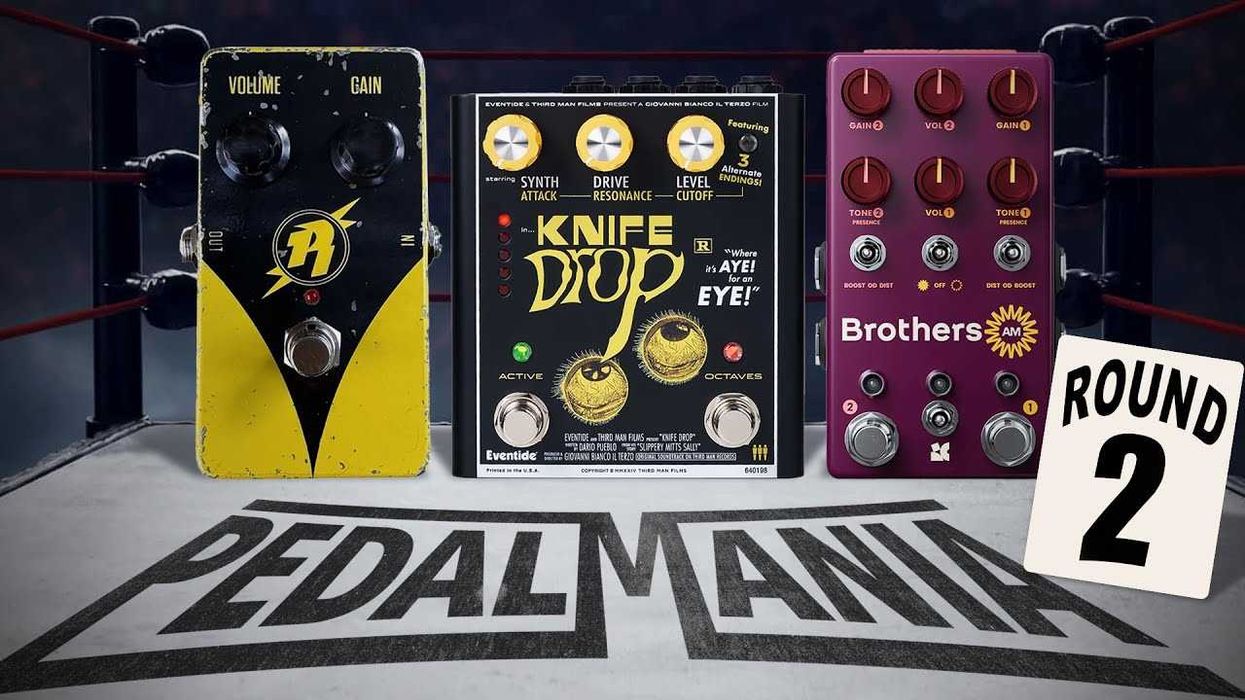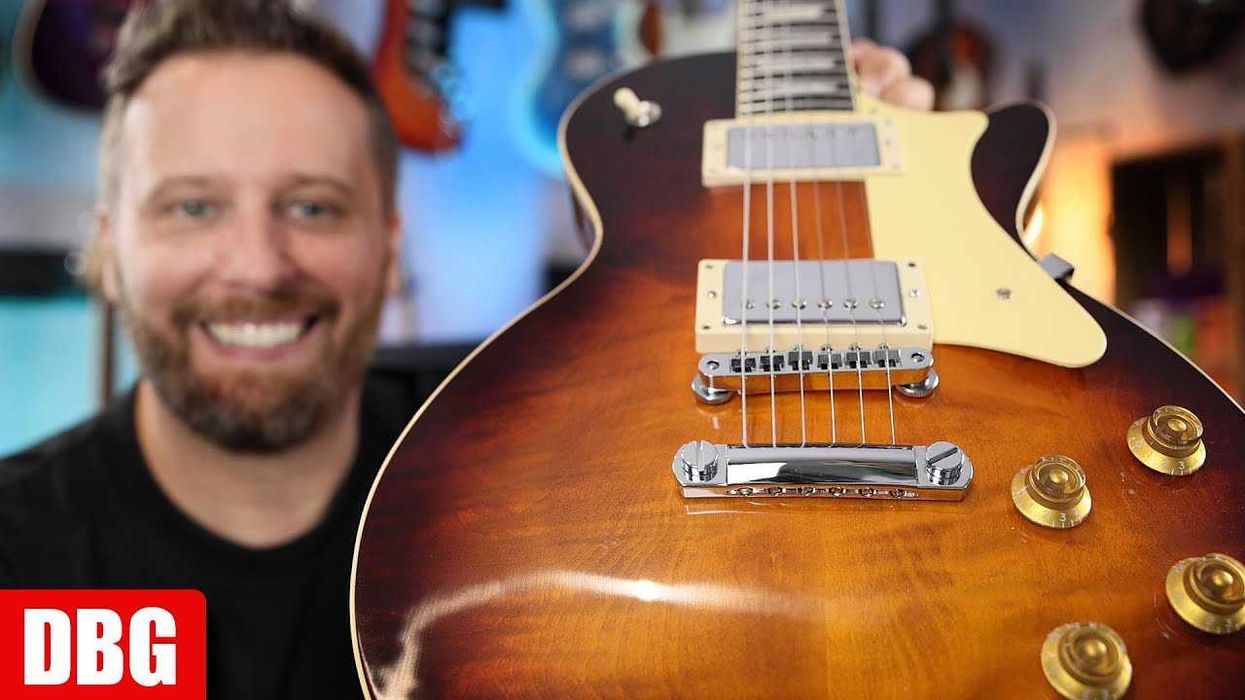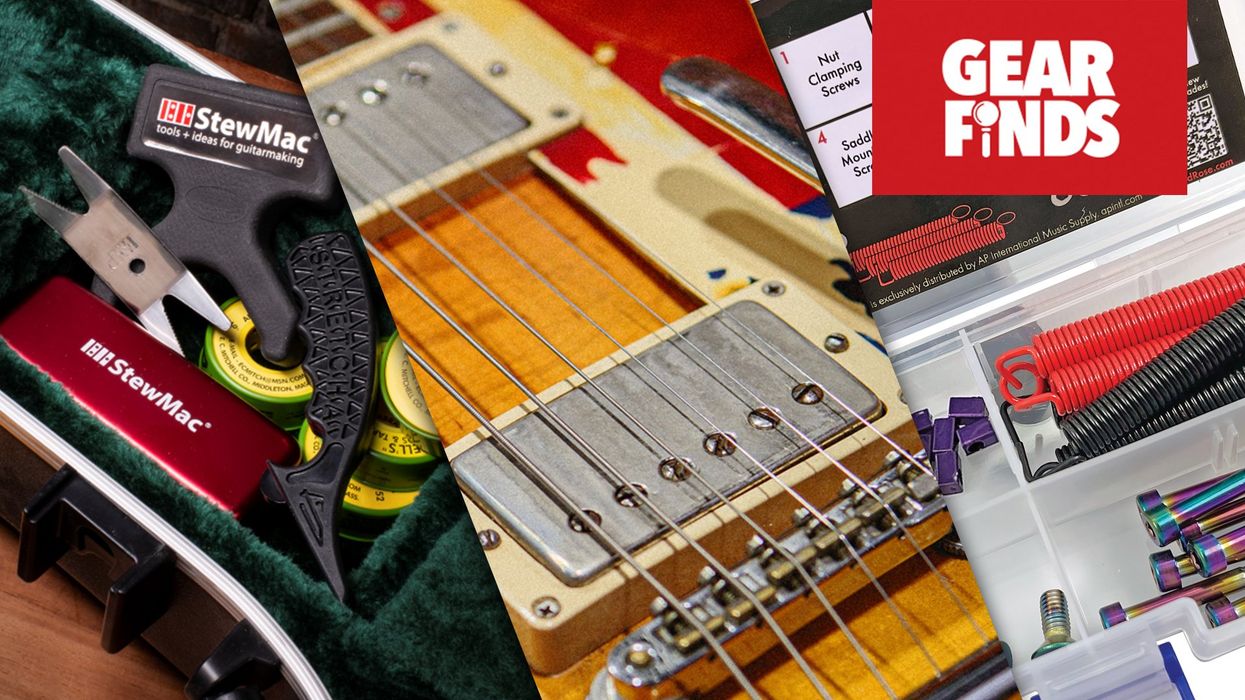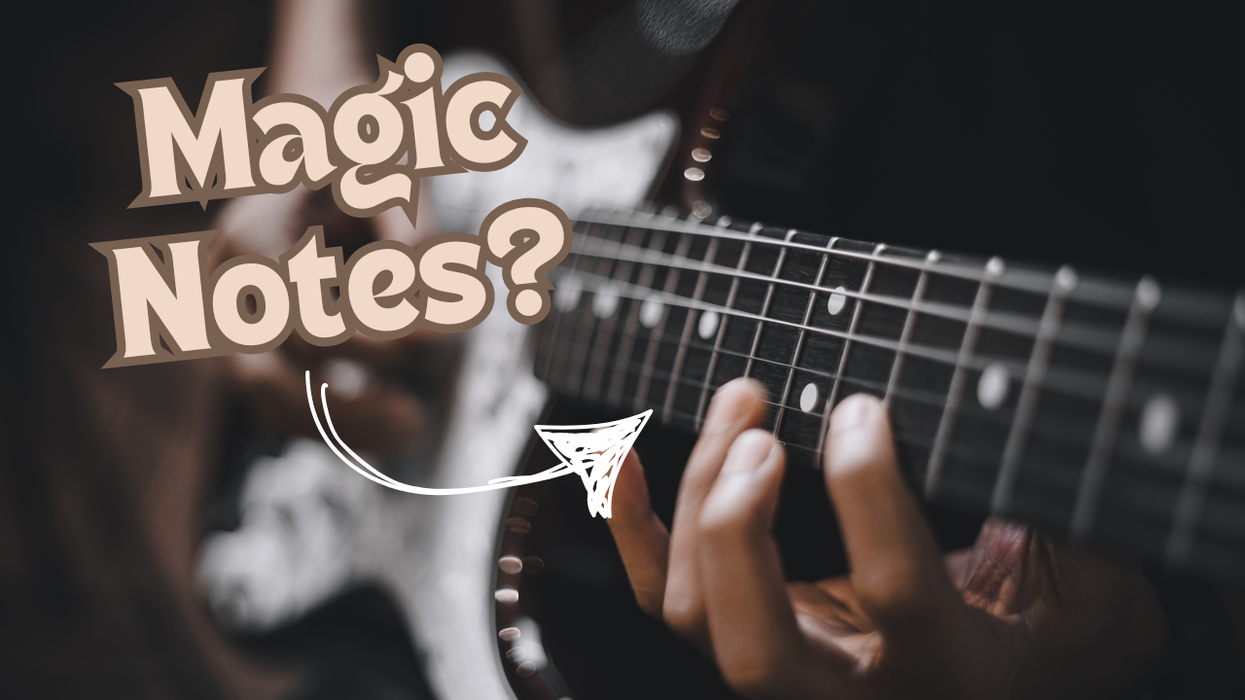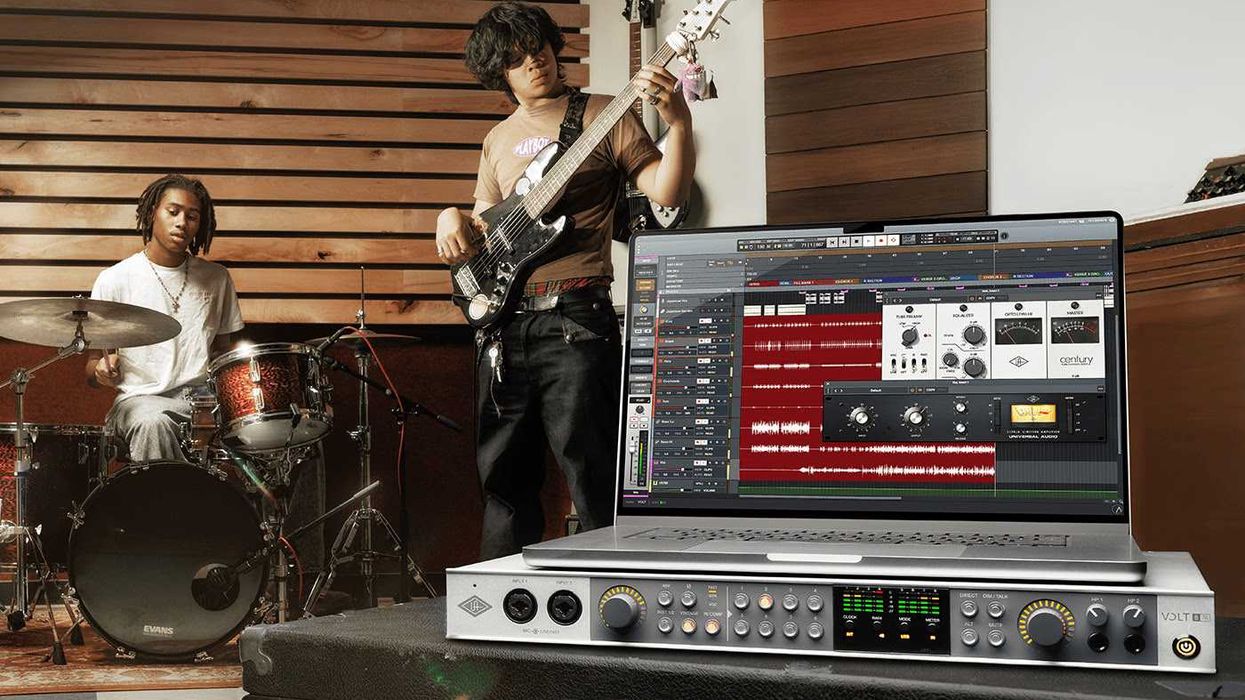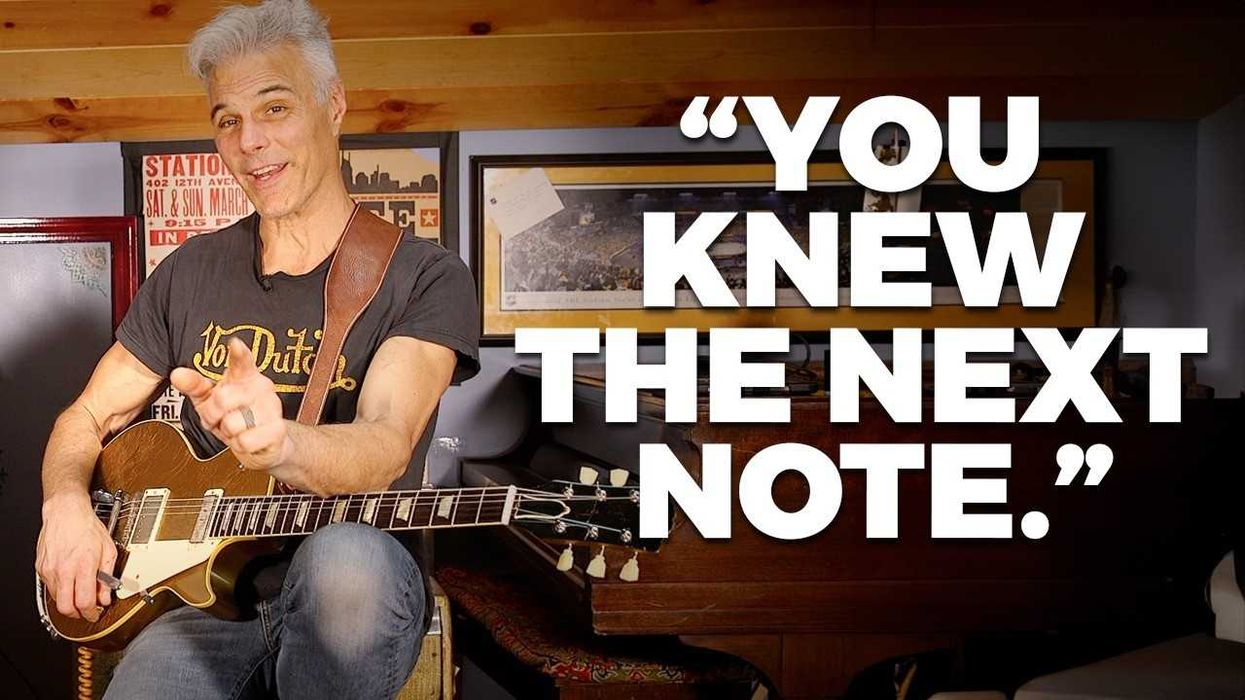
Perhaps it was the recent record set by the world’s largest pedalboard, or just the fact that there’s such a wealth of different pedals out there, but (as you may have noticed) PG has gone pedal crazy this month. So it was only fitting that we round up as many pedals as we can possibly fit in these pages for reviews. We also rounded up nine stomp-happy tone junkies to test these pedals out—watch for their initials at the end of each review.
So whether you want to replicate Rory Gallagher’s Rangemaster tone on your Strat, achieve that luscious Leslie swirl without the back brace, or simply add some subtle compression to your signal, chances are you’ll find a pedal that will be at home on your board.
| Pedals Reviewed: | ||
| Fuzzes: Mad Professor Fire Red Fuzz Cusack Screamer Fuzz V2 Devi Ever Legend of Fuzz Oohlala Synth Mangler Visual Sound V2 Angry Fuzz Tim Champion Hissy Foot Delays: MXR Carbon Copy Delay Wampler Analog Echo Phaser: Mad Professor Tiny Orange Phaser | Chorus: Visual Sound Liquid Chorus Flanger: Hartman Analog Flanger Compressor: Visual Sound V2 Comp 66 Boosts: Moollon Class A Boost Dino''s Guitars Dynabox BSM RG Treble Booster BSM VX-T BSM RPA Lizard Leg Flying Dragon Demeter MB-2B Fat Control | Tremolo/Rotary: DLS Effects RotoSIM Seymour Duncan Shape Shifter Overdrives: Himmelstrutz Elektro Art Fetto Dino''s Guitars Rust Box Geek MacDaddy British Ball Breaker Bass: Electro-Harmonix Bass Metaphors Aguilar Tone Hammer Misc.: Pigtronix Attack Sustain ISP G-String Decimator |
By Chris Burgess, Kenny Rardin, Michael Ross, Sean O’Brien Smith, Dirk Wacker, Gary Guzman, Jordan Wagner, Dan Berkowitz and Adam Moore
Fuzzes
Mad Professor Fire Red Fuzz
Hailing from the taiga forests and icy climes of Finland, Mad Professor’s Fire Red Fuzz brings some European civility to the down and dirty world of fuzz boxes. Featuring three white knobs—Volume, Tone and Fuzz—atop a (heavily built) fire engine red box, the first thing you’ll notice is that this pedal would be exceptionally easy to identify on a dark stage. The second thing you’ll notice is that this silicon-powered circuit is quite the chameleon, all thanks to an understated Tone control.
With the control set at 8 o’ clock, the Fire Red Fuzz produces a deep, mellow fuzz reminiscent of a classic rock festival; turning the Tone to noon provides a slight midcut and a modern tonality; rotating it all the way to the right rewards users with a bright, electric wire tonality, perfect for cutting sharp solos (I should mention that it never became too biting or thin). While the Fuzz knob can itself provide a broad range of thickness, from a subtle fuzz around the perimeter to a crushing wall of bricks, the rate of return ultimately drops off after 2 o’clock, with some of that early nuance disappearing. That said, this pedal has to be one of the most versatile fuzzes I’ve played with, and I frequently found myself clicking it on, even with an array of other fuzzes and ODs at my feet.
There’s plenty of volume to be had here, the Fire Red Fuzz features a deeply compressed sound at every point and sustain for days. Although the current weakness of the dollar has effectively positioned this offering from Mad Professor at the top end of the boutique price scale, if you’re looking for a versatile, great sounding fuzz, you would definitely be wise to look here. – AM
Cusack Screamer Fuzz V2
Finding a versatile distortion pedal can be a challenge, but finding a versatile fuzz pedal that plays nicely with the other can be even harder. The Cusack Screamer Fuzz attempts to alleviate this problem by combining both effects in one compact package. Jon Cusack has already proven that he’s an exceptional pedal designer, most notably with the Cusack Screamer, and the Screamer Fuzz is no exception. There are four controls on the MXR-sized unit: Level, Fuzz, Scream (distortion), and a 3- postion selector switch that allows you to choose different types of clipping diodes. Different positions of this switch can run the signal through an internal LED diode for asymmetrical clipping, a subdued mode referred to as “crushed”, and the stock Screamer tone.
Grabbing a set neck 1978 Ibanez Iceman with Seymour Duncan pickups, I plugged the pedal into a Crate V33 tube half stack. One of the best things about this pedal is that you don’t have to use both distortion modes at the same time, so the fuzz was set to 0, and the scream control was set to the 1 o’clock position. The tone it produced was very reminiscent of older era AC/DC; every note in every open chord was perfectly audible and even. The pedal cleaned up to a crystal clear clean tone with the guitar volume rolled down, and there was no loss in volume. After turning down the scream knob and turning up the fuzz control, I couldn’t help but play the Stones’ “Satisfaction.” It really reminded me of that old Maestro Fuzztone with all those great horn-like overtones. There was a very noticeable volume increase with the fuzz control however, much more than the scream control. For this experiment, I used the different diode positions. The LED mode seemed to have the most volume.
For the price, this is a very versatile fuzz with an impressive distortion section. The large volume difference between the two is unfortunate, but negligible when you hear the outstanding tone of this pedal. – JW
Devi Ever Legend of Fuzz
If you’ve had a hankering for recreating lo-fi 8-bit video game sounds with a guitar and amp, read on. Devi Ever’s Legend of Fuzz is an unassuming pedal, housed in an MXR-sized enclosure with two knobs, Volume and Control, and dressed with a label that will be familiar to any fans of Link. But rather than providing your usual fuzz fare, this high-gain, siliconbased pedal creates intense, saw-toothed shaped fuzz tones that will have you digging for that Nintendo in the basement.
The Volume knob acts as you would expect, adding an immense amount of gain into the signal; the Control knob changes the fuzz intensity and texture, sometimes dramatically, with only minor tweaks of the knob. With the Control knob turned all the way down, notes lose their decay and the Legend of Fuzz spits out short, fuzzy burps of sound—a unique enough effect in its own right and something that would sound absolutely killer on bass. Turning the Control knob up to about 9 o’clock provides you with a supersaturated tone and a hint of the sheer madness hiding within this pedal. As the Control knob moves past noon, the Legend of Fuzz begins generating all sorts of foreign noise. The low-end farts and breaks apart massively. Notes up high sing and sustain before gradually being pulled into the gain surrounding them. Things become unstable and unpredictable. Everything is compressed. You may think you’re playing a synth, or that your speakers are about to blow. Both are incorrect.
The Legend of Fuzz seems to have a mind of its own at times (not a putdown, mind you), and if you’re truly adventurous, you’ll love learning to “play” this pedal. If you’re into safer fuzzes, you may want to keep your distance; this pedal may corrupt your other boxes. – AM
Oohlala Synth Mangler
A lifetime of slick heist movies has taught me there are four archetypes essential to any good action team. There are the brains, the good-looking one and the obligatory muscle. And then there is the wild card. The wild card is capable of anything. They are uncontrollable and capricious. There is insanity lurking below the surface. But the wild card is also absolutely necessary. They make things happen; they scream the threats and pull the guns, consequences be damned. They are excitement, personified.
So what does this have to do with effects pedals? Simply put, I have never encountered a wild card quite like the Synth Mangler. Designed by Devi Ever and posing meekly as two fuzz circuits in one box (Oohlala’s Soda Meiser fuzzes) the Mangler has the capability of throwing your welldesigned effects team a curveball.
You control the gain level of the two fuzz channels with a mini-joystick, the Y-axis controlling the gain of the first channel and the X-axis controlling the gain of the second. Under the joystick lie two Volume knobs, and under those lie a series of four switches, labeled C1, H1, C2 and H2. These switches are the real mysteries of the Synth Mangler. Each switch “removes a component from the circuit, destabilizing it,” and introduces a new level of chaos. Flipping off the C switch turned everything into a turbulent, fizzed-out wall of bees, reminiscent of an Ampeg Scrambler. Flipping the H switch introduced a droning sound that slowly emerged from the background and then swallowed my signal whole, eventually erupting into a mass of static and feedback. With multiple switches flipped, moving the joystick is an experiment in sound; while it’s nearly impossible to describe it, I can say that you’ve likely never heard a sonic deconstruction this exciting or intense. Long live the wild card. – AM
Visual Sound V2 Angry Fuzz
This fuzz is unique in that unlike the Octavia or other vintage pedals, the octave circuit here can be blended into or out of the fuzz sound. A pair of knobs set Volume and Fuzz levels, and a mini-toggle turns a Bright switch on or off. The Anger Level knob blends in the Octave circuit— I am not sure about the connection between octaves and antagonism, but the Angry Fuzz does offer the possibility of some truly demented tones. Cranking the octave level and backing off your guitar volume creates some delightful, or horrible (depending on your personal level of dementia) bit-reduction sounds. At lower fuzz settings, I was able to achieve an exciting electric sitar effect. At any volume level, single notes give you one octave up, while two-note chords create an octave up, plus some cool lower octave artifacts.
I found the Angry Fuzz to be incredibly flexible. Turning off the octave and cranking the fuzz offered a smooth, Big Muff-style fuzz, with tons of sustain for Frippertronic excursions, though it lacked some of the EH pedal’s low-end girth and articulation. Backing off the fuzz about halfway, I was able to clean up the sound with the guitar volume.
Turning up the octave knob after 10 o’clock reveals subtle changes in the amount of upper harmonics, with the effect quite evident past noon. Unlike many vintage fuzz units, the Angry Fuzz sounds are all smooth and quiet. If it lacks anything, it is the unpredictability and quirkiness that give old designs like the Fender Blender and Ampeg Scrambler their character. On the other hand, Angry Fuzz offers great sound, combined with reliability and dependable, repeatable performance. Angry or not, you may want to grab it for the octave alone. – MR
Tim Champion Hissy Foot
Tim Champion originally made guitar pedals for his own use in his Sandpile recording studio in New York City. The guitar pedals are based on his personal favorites that deliver that classic vintage tone, and he is now sharing his creations with guitarists worldwide.
One of the pedals he created for his studio and live work was based on a vintage style Fuzz Face, which is the fuzz pedal that Jimi Hendrix used throughout his career. Tim named it the Hissy Foot, which features point to point hand wired construction, vintage style PNP Germanium transistors, and true bypass. He took the concept of the Fuzz Face one step further by adding “Hendrix” modifications such as adding gain and toning down the biting high end aspects of PNP Germanium transistor base fuzz. The end result is a hot-rodded Fuzz Face-style pedal that has a darker tone and more gain than the original.
The pedal’s specs are simple and to the point: an on/off footswitch, input and output jacks, and Volume and Fuzz control knobs. The Hissy Foot is built very well with an aluminum box that is sturdy and road-worthy, yet very lightweight. Also, you’ll have no problems knowing when it’s on—it has the brightest LED light that I’ve ever seen on a pedal. (It can actually be blinding if you look into it directly!) I plugged into the pedal, cranked up the fuzz and was instantly welcomed with a thick, round fuzz sound. There is a ton of gain and plenty of bottom end—definitely not a thin sounding pedal at all! It has a darker quality to it with a bassy to midtoned fuzz that I liked, although the tone may be too dark for some. It responds well to both single coil and humbucking pickups and also cleans up nicely when you roll off the volume.
The Hissy Foot is a well-built fuzz box that recreates the vintage-style fuzz of the past. If you’re looking for a modded Fuzz Face-style pedal similar to what Hendrix used, then the Hissy Foot is for you. – GG
 | |
| Download example 1 Volume at 10:00, Tone at 9:00, Fuzz at 4:00; a deep, thick wall of fuzz. | |
| Download example 2 Volume at 10:00, Tone at 4:00, Fuzz at 1:30; a biting lead fuzz tone. | |
| Guitar by Randall Davis. Recorded with an Ampeg AMG100 and a modified Epiphone Valve Junior stack featuring an Eminence Red Coat 12”, through a Shure SM57 and into a ProSonus Audiobox interface. | |
Hailing from the taiga forests and icy climes of Finland, Mad Professor’s Fire Red Fuzz brings some European civility to the down and dirty world of fuzz boxes. Featuring three white knobs—Volume, Tone and Fuzz—atop a (heavily built) fire engine red box, the first thing you’ll notice is that this pedal would be exceptionally easy to identify on a dark stage. The second thing you’ll notice is that this silicon-powered circuit is quite the chameleon, all thanks to an understated Tone control.
With the control set at 8 o’ clock, the Fire Red Fuzz produces a deep, mellow fuzz reminiscent of a classic rock festival; turning the Tone to noon provides a slight midcut and a modern tonality; rotating it all the way to the right rewards users with a bright, electric wire tonality, perfect for cutting sharp solos (I should mention that it never became too biting or thin). While the Fuzz knob can itself provide a broad range of thickness, from a subtle fuzz around the perimeter to a crushing wall of bricks, the rate of return ultimately drops off after 2 o’clock, with some of that early nuance disappearing. That said, this pedal has to be one of the most versatile fuzzes I’ve played with, and I frequently found myself clicking it on, even with an array of other fuzzes and ODs at my feet.
There’s plenty of volume to be had here, the Fire Red Fuzz features a deeply compressed sound at every point and sustain for days. Although the current weakness of the dollar has effectively positioned this offering from Mad Professor at the top end of the boutique price scale, if you’re looking for a versatile, great sounding fuzz, you would definitely be wise to look here. – AM
Buy If...
you want a versatile fuzz that can cover a lot of ground.
Skip If...
you’re a noise aficionado
Rating...
MSRP $347 - Mad Professor - mpamp.com |
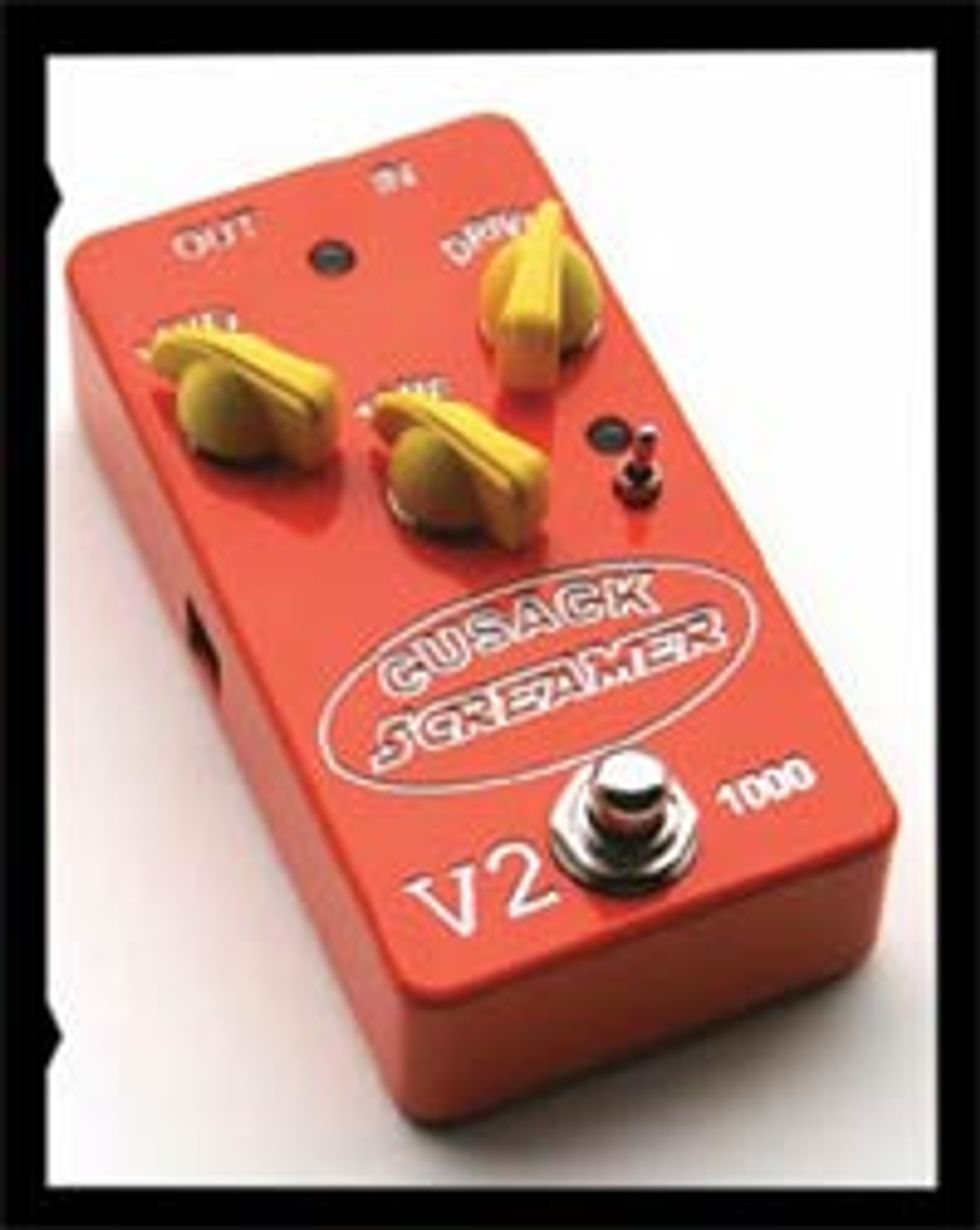 |
Finding a versatile distortion pedal can be a challenge, but finding a versatile fuzz pedal that plays nicely with the other can be even harder. The Cusack Screamer Fuzz attempts to alleviate this problem by combining both effects in one compact package. Jon Cusack has already proven that he’s an exceptional pedal designer, most notably with the Cusack Screamer, and the Screamer Fuzz is no exception. There are four controls on the MXR-sized unit: Level, Fuzz, Scream (distortion), and a 3- postion selector switch that allows you to choose different types of clipping diodes. Different positions of this switch can run the signal through an internal LED diode for asymmetrical clipping, a subdued mode referred to as “crushed”, and the stock Screamer tone.
Grabbing a set neck 1978 Ibanez Iceman with Seymour Duncan pickups, I plugged the pedal into a Crate V33 tube half stack. One of the best things about this pedal is that you don’t have to use both distortion modes at the same time, so the fuzz was set to 0, and the scream control was set to the 1 o’clock position. The tone it produced was very reminiscent of older era AC/DC; every note in every open chord was perfectly audible and even. The pedal cleaned up to a crystal clear clean tone with the guitar volume rolled down, and there was no loss in volume. After turning down the scream knob and turning up the fuzz control, I couldn’t help but play the Stones’ “Satisfaction.” It really reminded me of that old Maestro Fuzztone with all those great horn-like overtones. There was a very noticeable volume increase with the fuzz control however, much more than the scream control. For this experiment, I used the different diode positions. The LED mode seemed to have the most volume.
For the price, this is a very versatile fuzz with an impressive distortion section. The large volume difference between the two is unfortunate, but negligible when you hear the outstanding tone of this pedal. – JW
Buy If...
you need great-sounding fuzz and distortion that can be combined or used separately
Skip If...
you need a more modern, midscooped fuzz tone.
Rating...
MSRP $225 - Cusack Music - cusackmusic.com |
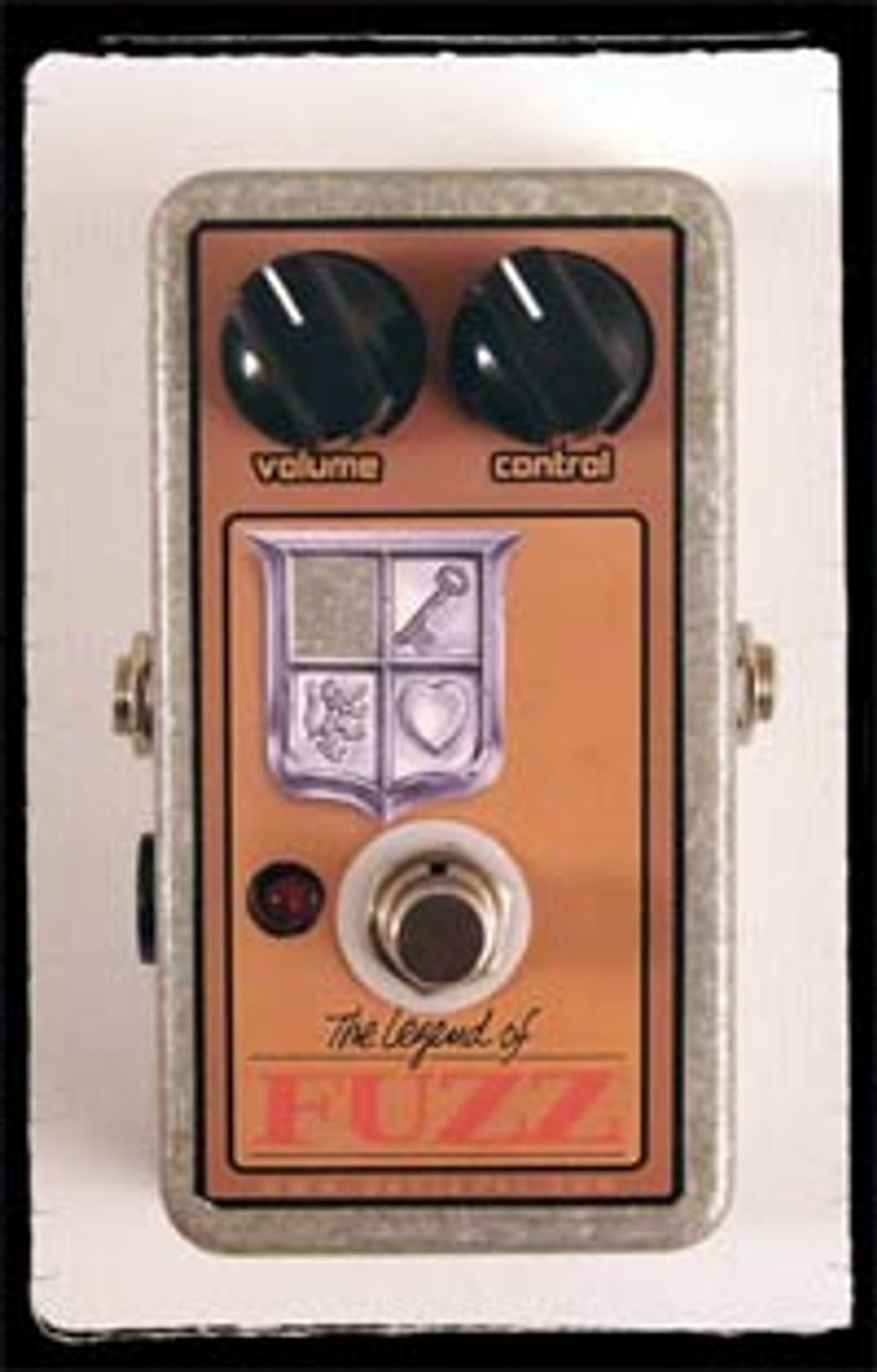 | |
| Download example 1 Volume at 1:00, Control at 10:30; right before it goes over the edge. | |
| Download example 2 Volume at 1:00, Control at 3:00 completely over the edge. | |
| Guitar by Randall Davis. Recorded with a Fender SSH Strat and a modified Epiphone Valve Junior stack featuring an Eminence Red Coat 12”, through a Shure SM57 and into a ProSonus Audiobox interface. | |
If you’ve had a hankering for recreating lo-fi 8-bit video game sounds with a guitar and amp, read on. Devi Ever’s Legend of Fuzz is an unassuming pedal, housed in an MXR-sized enclosure with two knobs, Volume and Control, and dressed with a label that will be familiar to any fans of Link. But rather than providing your usual fuzz fare, this high-gain, siliconbased pedal creates intense, saw-toothed shaped fuzz tones that will have you digging for that Nintendo in the basement.
The Volume knob acts as you would expect, adding an immense amount of gain into the signal; the Control knob changes the fuzz intensity and texture, sometimes dramatically, with only minor tweaks of the knob. With the Control knob turned all the way down, notes lose their decay and the Legend of Fuzz spits out short, fuzzy burps of sound—a unique enough effect in its own right and something that would sound absolutely killer on bass. Turning the Control knob up to about 9 o’clock provides you with a supersaturated tone and a hint of the sheer madness hiding within this pedal. As the Control knob moves past noon, the Legend of Fuzz begins generating all sorts of foreign noise. The low-end farts and breaks apart massively. Notes up high sing and sustain before gradually being pulled into the gain surrounding them. Things become unstable and unpredictable. Everything is compressed. You may think you’re playing a synth, or that your speakers are about to blow. Both are incorrect.
The Legend of Fuzz seems to have a mind of its own at times (not a putdown, mind you), and if you’re truly adventurous, you’ll love learning to “play” this pedal. If you’re into safer fuzzes, you may want to keep your distance; this pedal may corrupt your other boxes. – AM
Buy If...
you want to induce Atari flashbacks.
Skip If...
you really just want a Fuzz Face.
Rating...
MSRP $95 - Devi Ever - deviever.com |
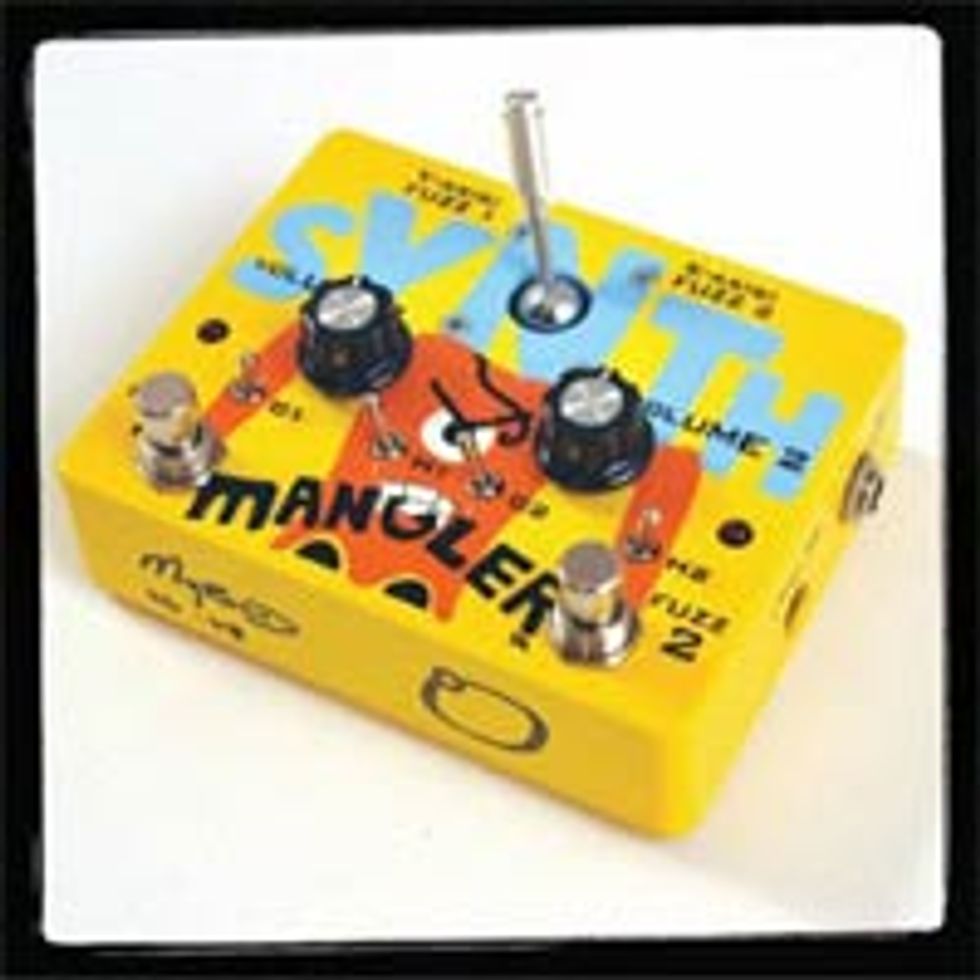 | |
| Download example 1 Fuzz 2 engaged, Volume 1 at 11:00, gain set at 50%; the sound of the Soda Meiser fuzz at medium gain. | |
| Download example 2 Fuzz 1 and 2 engaged, Volume 1 at 11:00, Volume 2 at 9:00, gain set at 50% (X and Y axis); the sound of both channels running at once. | |
| Download example 3 Begins the same as example 2, then the C1 and H1 switches, for both channels, are flipped in and out of the signal. The joystick is also rotated. | |
| Recorded with an Ampeg AMG100 and a modified Epiphone Valve Junior stack featuring an Eminence Red Coat 12”, through a Shure SM57 and into a ProSonus Audiobox interface. | |
A lifetime of slick heist movies has taught me there are four archetypes essential to any good action team. There are the brains, the good-looking one and the obligatory muscle. And then there is the wild card. The wild card is capable of anything. They are uncontrollable and capricious. There is insanity lurking below the surface. But the wild card is also absolutely necessary. They make things happen; they scream the threats and pull the guns, consequences be damned. They are excitement, personified.
So what does this have to do with effects pedals? Simply put, I have never encountered a wild card quite like the Synth Mangler. Designed by Devi Ever and posing meekly as two fuzz circuits in one box (Oohlala’s Soda Meiser fuzzes) the Mangler has the capability of throwing your welldesigned effects team a curveball.
You control the gain level of the two fuzz channels with a mini-joystick, the Y-axis controlling the gain of the first channel and the X-axis controlling the gain of the second. Under the joystick lie two Volume knobs, and under those lie a series of four switches, labeled C1, H1, C2 and H2. These switches are the real mysteries of the Synth Mangler. Each switch “removes a component from the circuit, destabilizing it,” and introduces a new level of chaos. Flipping off the C switch turned everything into a turbulent, fizzed-out wall of bees, reminiscent of an Ampeg Scrambler. Flipping the H switch introduced a droning sound that slowly emerged from the background and then swallowed my signal whole, eventually erupting into a mass of static and feedback. With multiple switches flipped, moving the joystick is an experiment in sound; while it’s nearly impossible to describe it, I can say that you’ve likely never heard a sonic deconstruction this exciting or intense. Long live the wild card. – AM
Buy If...
you have an itching to create some sonic chaos.
Skip If...
your vibe is more Oceans 11 than The A Team.
Rating...
MSRP $315 - Oohlala Manufacturing - oohlalamanufacturing.com |
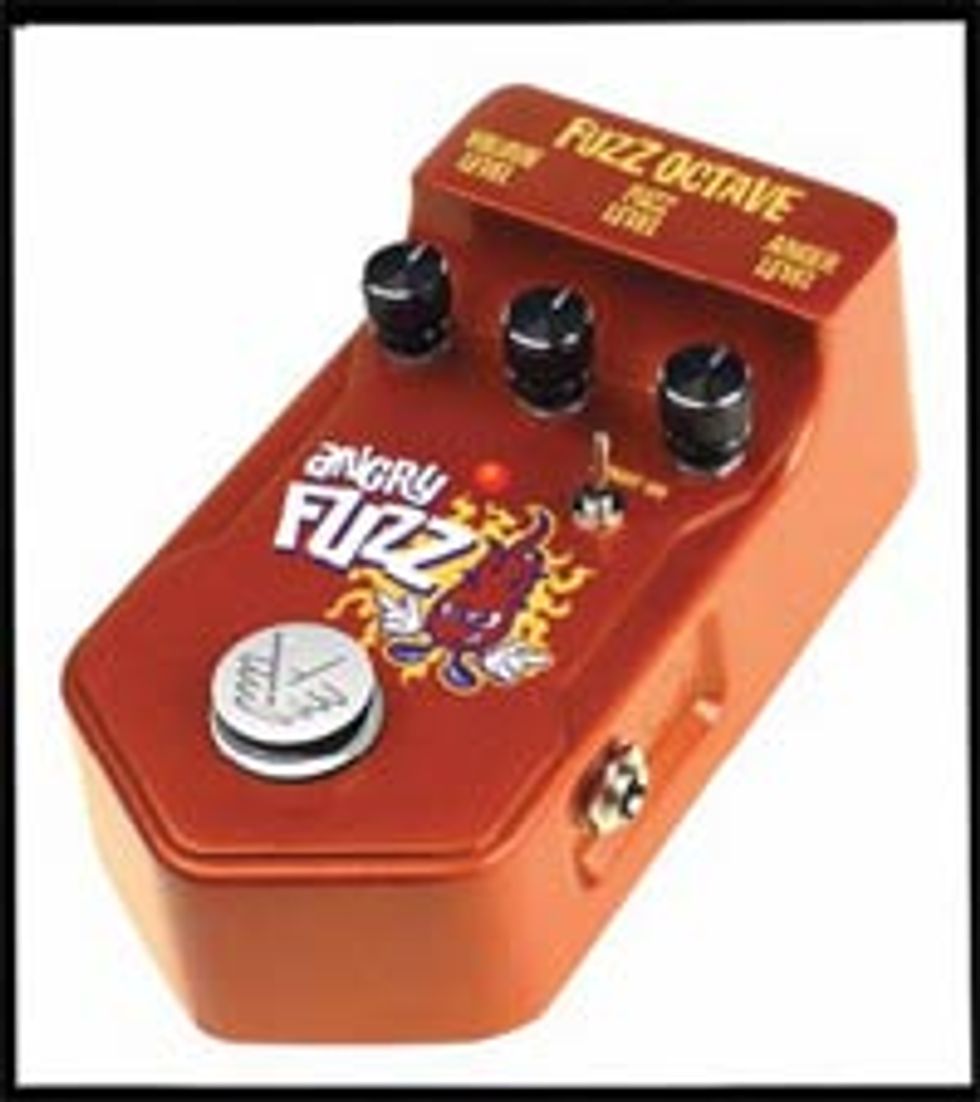 |
This fuzz is unique in that unlike the Octavia or other vintage pedals, the octave circuit here can be blended into or out of the fuzz sound. A pair of knobs set Volume and Fuzz levels, and a mini-toggle turns a Bright switch on or off. The Anger Level knob blends in the Octave circuit— I am not sure about the connection between octaves and antagonism, but the Angry Fuzz does offer the possibility of some truly demented tones. Cranking the octave level and backing off your guitar volume creates some delightful, or horrible (depending on your personal level of dementia) bit-reduction sounds. At lower fuzz settings, I was able to achieve an exciting electric sitar effect. At any volume level, single notes give you one octave up, while two-note chords create an octave up, plus some cool lower octave artifacts.
I found the Angry Fuzz to be incredibly flexible. Turning off the octave and cranking the fuzz offered a smooth, Big Muff-style fuzz, with tons of sustain for Frippertronic excursions, though it lacked some of the EH pedal’s low-end girth and articulation. Backing off the fuzz about halfway, I was able to clean up the sound with the guitar volume.
Turning up the octave knob after 10 o’clock reveals subtle changes in the amount of upper harmonics, with the effect quite evident past noon. Unlike many vintage fuzz units, the Angry Fuzz sounds are all smooth and quiet. If it lacks anything, it is the unpredictability and quirkiness that give old designs like the Fender Blender and Ampeg Scrambler their character. On the other hand, Angry Fuzz offers great sound, combined with reliability and dependable, repeatable performance. Angry or not, you may want to grab it for the octave alone. – MR
Buy If...
you want a well built, great sounding, versatile octave fuzz pedal
Skip If...
unpredictability and quirkiness floats your boat.
Rating...
MSRP $207 - Visual Sound - visualsound.net |
 | |
| Download example 1 | |
| Recorded with a Fender VG Strat with humbucking pickup setting. The signal went through an Avalon Vt737sp preamp recorded into Pro Tools with Native Instruments Guitar Rig 4x12 Tweed Alnico cabinet sim. | |
Tim Champion originally made guitar pedals for his own use in his Sandpile recording studio in New York City. The guitar pedals are based on his personal favorites that deliver that classic vintage tone, and he is now sharing his creations with guitarists worldwide.
One of the pedals he created for his studio and live work was based on a vintage style Fuzz Face, which is the fuzz pedal that Jimi Hendrix used throughout his career. Tim named it the Hissy Foot, which features point to point hand wired construction, vintage style PNP Germanium transistors, and true bypass. He took the concept of the Fuzz Face one step further by adding “Hendrix” modifications such as adding gain and toning down the biting high end aspects of PNP Germanium transistor base fuzz. The end result is a hot-rodded Fuzz Face-style pedal that has a darker tone and more gain than the original.
The pedal’s specs are simple and to the point: an on/off footswitch, input and output jacks, and Volume and Fuzz control knobs. The Hissy Foot is built very well with an aluminum box that is sturdy and road-worthy, yet very lightweight. Also, you’ll have no problems knowing when it’s on—it has the brightest LED light that I’ve ever seen on a pedal. (It can actually be blinding if you look into it directly!) I plugged into the pedal, cranked up the fuzz and was instantly welcomed with a thick, round fuzz sound. There is a ton of gain and plenty of bottom end—definitely not a thin sounding pedal at all! It has a darker quality to it with a bassy to midtoned fuzz that I liked, although the tone may be too dark for some. It responds well to both single coil and humbucking pickups and also cleans up nicely when you roll off the volume.
The Hissy Foot is a well-built fuzz box that recreates the vintage-style fuzz of the past. If you’re looking for a modded Fuzz Face-style pedal similar to what Hendrix used, then the Hissy Foot is for you. – GG
Buy If...
You like your fuzz tone like your milkshakes—very thick!
Skip If...
You fear the dark side of the Fuzz.
Rating...
MSRP $219 - Tim Champion Guitar Pedals - timchampionpedals.com |
Delays
MXR Carbon Copy Analog Delay
In the seemingly never-ending array of delay pedals and devices, it’s hard to come up with something new. The Carbon Copy is certainly in that category. Past attempts have always fallen a bit short of my expectations; this pedal is the first one that hasn’t.
The first commercially produced tape echo devices truly sounded great, but they had a few inherent problems, such as tape breakage and stretching, and they were unreliable. The devices designed to replace them were born of the early generation of chips and components—analog circuits. They were pretty good sounding units, but some felt that the repeats were not clear, especially with longer delay settings.
The Carbon Copy delay does not seem to have any of the inherent problems that plagued earlier analog units. This unit can produce long delay times that still retain great tone—not “clanky” or brittle. The short slapback delays, like those used in country music, are tight and do not muddy up. The regeneration or repeats setting on this pedal provided a naturally occurring trail of echos that was never apparent on most older units—never too much or too little. The Mix knob is graduated to provide exact amounts of delay versus dry. There is also a modulation that replicates the tape warble found in older tape units. I think this is a great feature.
The MXR Carbon Copy is one of the most musical analog delays I’ve ever tried. It’s well made, as are all MXR products. The controls are very easy, and a great tone can be achieved without much effort. A great pedal. – KR
Wampler Analog Echo
Brian Wampler’s “Analog Echo” is loaded with a digital delay chip, but with pure analog circuitry surrounding in order to achieve tape echo or Echoplex-type delay tones with a 650ms maximum delay time. It’s true bypass and housed in a very cool “fire orange” powder coated box (3.5 x 4.5) with white knobs and graphics. It offers the typical controls for Level, Repeats and Delay Time, plus a unique tone control for the tonality of the echoes, making it possible to get a warm analog tone or a fat tape echo tone without resorting to modulation on the echoes. Besides the status LED right above the footswitch, the Delay is equipped with a second, flashing LED indicating the delay time, which I found very useful. Inside you can find professional craftsmanship at its best; Brian only used the finest parts— low-tolerance metal film resistors, stacked metal film and silver mica caps, gold plated IC sockets, etc. I wish all boutique pedals would look like this! The pedal can be powered by an internal 9V battery or an external wall-wart (barrel plug like Boss/ Ibanez) and can handle power up to 18V for some more clean headroom if needed.
After plugging in my Tele, I was suprised how good this pedal sounded. It reminds me a lot of the old TC Electronic Analog Delay—smooth and clear at the same time, with tons of tonal potential. With the tone control, you can dial in all shades between warm analog and a fat tape echo tone and with a slapback setting, you can easily mimic the old famous Sun Records “tiled bathroom” rockabilly tone we all love so much. Compared with my old Boss DM-3, the Wampler Analog Echo sounds fuller and warmer, more focused and without any signal degeneration at longer delay settings. This pedal is a keeper and a “must try” for everyone who is serious about a good delay tone. – DW
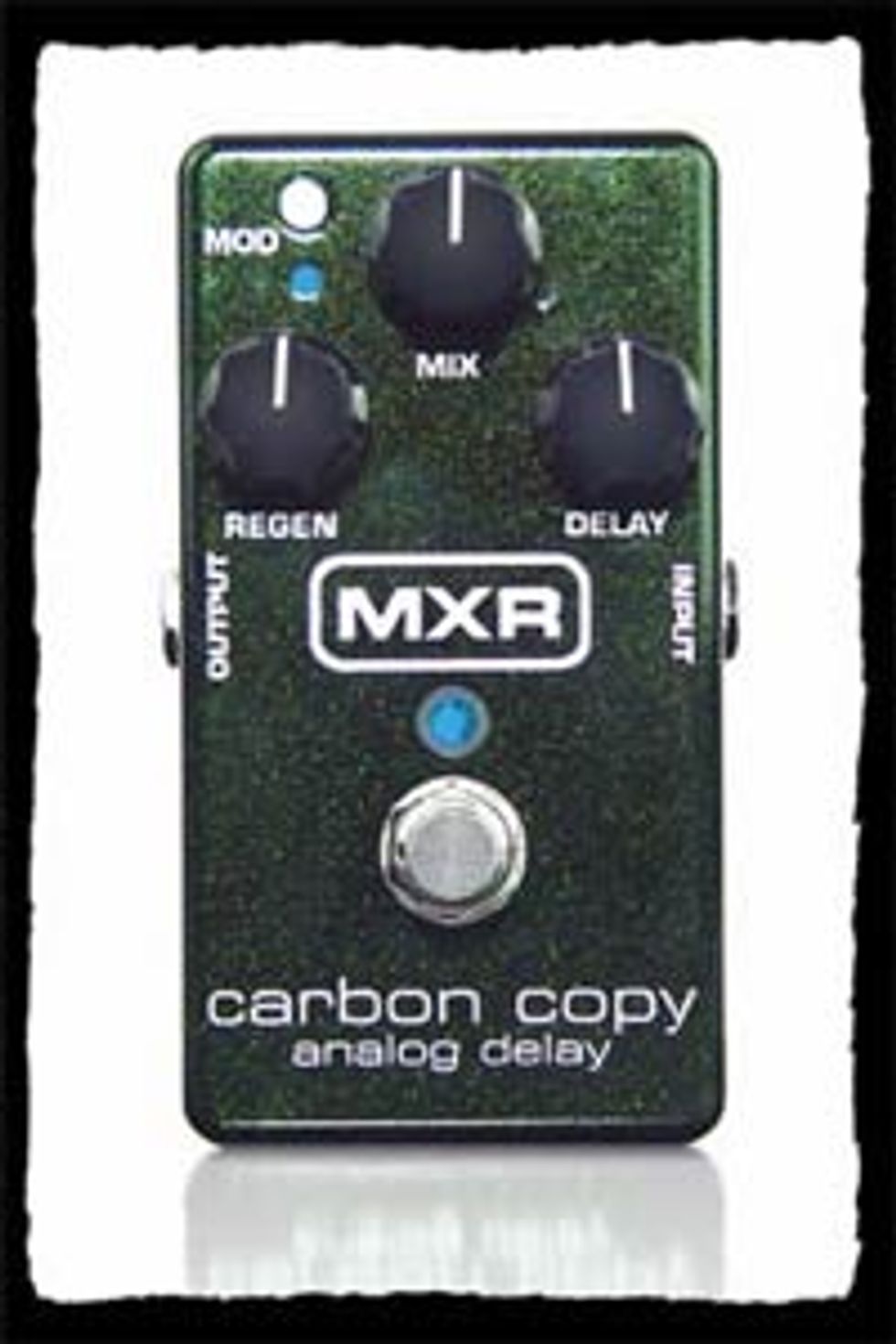 |
In the seemingly never-ending array of delay pedals and devices, it’s hard to come up with something new. The Carbon Copy is certainly in that category. Past attempts have always fallen a bit short of my expectations; this pedal is the first one that hasn’t.
The first commercially produced tape echo devices truly sounded great, but they had a few inherent problems, such as tape breakage and stretching, and they were unreliable. The devices designed to replace them were born of the early generation of chips and components—analog circuits. They were pretty good sounding units, but some felt that the repeats were not clear, especially with longer delay settings.
The Carbon Copy delay does not seem to have any of the inherent problems that plagued earlier analog units. This unit can produce long delay times that still retain great tone—not “clanky” or brittle. The short slapback delays, like those used in country music, are tight and do not muddy up. The regeneration or repeats setting on this pedal provided a naturally occurring trail of echos that was never apparent on most older units—never too much or too little. The Mix knob is graduated to provide exact amounts of delay versus dry. There is also a modulation that replicates the tape warble found in older tape units. I think this is a great feature.
The MXR Carbon Copy is one of the most musical analog delays I’ve ever tried. It’s well made, as are all MXR products. The controls are very easy, and a great tone can be achieved without much effort. A great pedal. – KR
Buy If...
you’re looking for a great, useable delay for all genres of music.
Skip If...
you’re looking for the harder sound of a Digital Delay.
Rating...
MSRP $254.61 - MXR - jimdunlop.com |
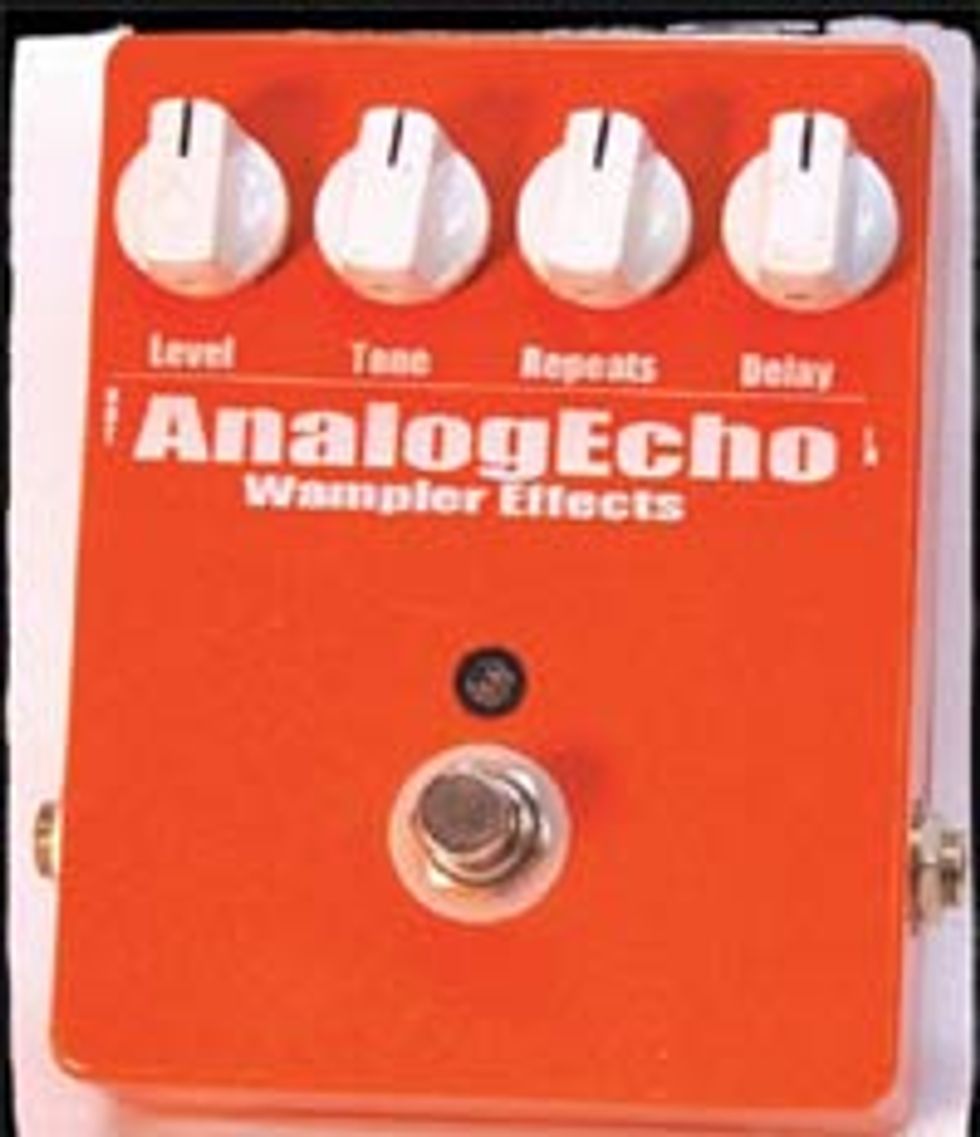 |
Brian Wampler’s “Analog Echo” is loaded with a digital delay chip, but with pure analog circuitry surrounding in order to achieve tape echo or Echoplex-type delay tones with a 650ms maximum delay time. It’s true bypass and housed in a very cool “fire orange” powder coated box (3.5 x 4.5) with white knobs and graphics. It offers the typical controls for Level, Repeats and Delay Time, plus a unique tone control for the tonality of the echoes, making it possible to get a warm analog tone or a fat tape echo tone without resorting to modulation on the echoes. Besides the status LED right above the footswitch, the Delay is equipped with a second, flashing LED indicating the delay time, which I found very useful. Inside you can find professional craftsmanship at its best; Brian only used the finest parts— low-tolerance metal film resistors, stacked metal film and silver mica caps, gold plated IC sockets, etc. I wish all boutique pedals would look like this! The pedal can be powered by an internal 9V battery or an external wall-wart (barrel plug like Boss/ Ibanez) and can handle power up to 18V for some more clean headroom if needed.
After plugging in my Tele, I was suprised how good this pedal sounded. It reminds me a lot of the old TC Electronic Analog Delay—smooth and clear at the same time, with tons of tonal potential. With the tone control, you can dial in all shades between warm analog and a fat tape echo tone and with a slapback setting, you can easily mimic the old famous Sun Records “tiled bathroom” rockabilly tone we all love so much. Compared with my old Boss DM-3, the Wampler Analog Echo sounds fuller and warmer, more focused and without any signal degeneration at longer delay settings. This pedal is a keeper and a “must try” for everyone who is serious about a good delay tone. – DW
Buy If...
you want an excellent analog-sounding delay, with an extended delay time without any signal degeneration
Skip If...
you need a cold, sterile, digital-sounding, ultra-versatile stompbox with a lot of knobs, presets, tap tempo, reverse delay and other gimmicks
Rating...
MSRP $249.99 - Wampler Pedals - wamplerpedals.com |
Phaser
Mad Professor Tiny Orange Phaser
Mad Professor has been quietly responsible for some of the most nuanced, usable effects to come out of the boutique scene in the last few years; the Tiny Orange Phaser in no exception. Much like their other pedals, things are kept clean and utilitarian, with three white knobs atop a shimmering orange body. The Speed knob has a respectable range, from slow and floating at its leftmost point to shimmery vibrato at its rightmost—the manual suggests parking the knob at noon for “classic” phase sounds, and I found this spot to be a common stopping point. The Resonance knob adjusts the peaks of the phase effect, allowing you to get a little more “sharpness” and cut out of the effect—note that this pedal is midrangefocused to give the effect more cutting power; if you’re looking for a greater range of tonal versatility, you’ll definitely want to test this before purchasing.
The Mix knob is the most unique feature here—turning the knob to the left rewards you with deeper, lusher phasing, while turning the knob past noon and to the right provides a more subtle, organic effect (parking the Mix knob at noon effectively turns the effect off, the utility of which I still don’t grasp). No matter which setting you find the mix knob on, the Tiny Orange Phaser has a full, vocal quality to it, almost like a good wah. Very tasty.
I would have liked to see a little more variation in the Resonance control and more phase depth. Of course, I’m still having daydreams about my singular encounter with Moog’s 12-stage phaser, so take that as you will. Those points aside, if you’re looking for a way to add some smooth and subtle movement to your lines, check out the orange offering from Finland. – AM
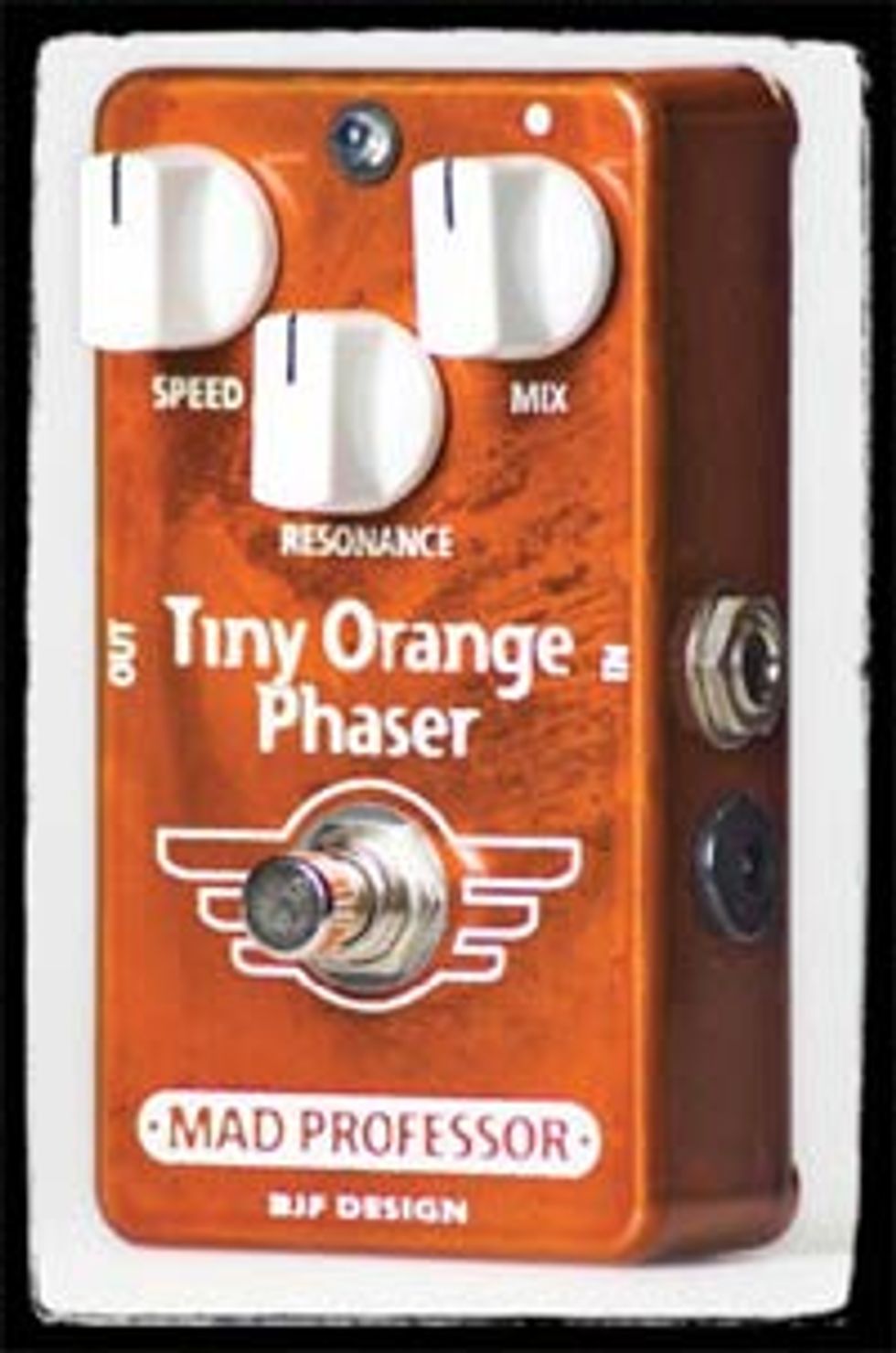 | |
| Download example 1 Speed at 11:00, Resonance at 3:00, Mix at 7:00; the deep end of the pedal. | |
| Download example 2 Speed at 11:00, Resonance at 3:00, Mix at 4:30; the lighter side of the phaser. | |
| Guitar by Randall Davis. Recorded with a Fender SSH Strat and a modified Epiphone Valve Junior stack featuring an Eminence Red Coat 12”, through a Shure SM57 and into a ProSonus Audiobox interface. | |
Mad Professor has been quietly responsible for some of the most nuanced, usable effects to come out of the boutique scene in the last few years; the Tiny Orange Phaser in no exception. Much like their other pedals, things are kept clean and utilitarian, with three white knobs atop a shimmering orange body. The Speed knob has a respectable range, from slow and floating at its leftmost point to shimmery vibrato at its rightmost—the manual suggests parking the knob at noon for “classic” phase sounds, and I found this spot to be a common stopping point. The Resonance knob adjusts the peaks of the phase effect, allowing you to get a little more “sharpness” and cut out of the effect—note that this pedal is midrangefocused to give the effect more cutting power; if you’re looking for a greater range of tonal versatility, you’ll definitely want to test this before purchasing.
The Mix knob is the most unique feature here—turning the knob to the left rewards you with deeper, lusher phasing, while turning the knob past noon and to the right provides a more subtle, organic effect (parking the Mix knob at noon effectively turns the effect off, the utility of which I still don’t grasp). No matter which setting you find the mix knob on, the Tiny Orange Phaser has a full, vocal quality to it, almost like a good wah. Very tasty.
I would have liked to see a little more variation in the Resonance control and more phase depth. Of course, I’m still having daydreams about my singular encounter with Moog’s 12-stage phaser, so take that as you will. Those points aside, if you’re looking for a way to add some smooth and subtle movement to your lines, check out the orange offering from Finland. – AM
Buy If...
you want a nuanced effect to add movement to your signal
Skip If...
you don’t want the midrange focus
Rating...
MSRP $398 - Mad Professor - mpamp.com |
Chorus
Visual Sound V2 Liquid Chorus
Visual Sound’s Liquid Chorus circuit uses analog Visual Sound “bucket brigade” chips, created using the same process as the legendary Panasonic Bucket Brigade Delay (BBD) chips. The fact that the company produces its own chips rather than using rare, expensive “New Old Stock” (NOS) allows Visual Sound to offer an analog chorus at a lower, more “digital” price.
Some chorus pedals offer only two controls, Speed and Depth. To these, Liquid Chorus adds Width and Delay Time. The Width knob thins or thickens out the chorus sound, while the Delay control sets the time of the delay sweep. All of this allows you to create a wide range of classic chorus effects. Unlike the H2O from which it is derived, the Liquid Chorus is “true stereo.” Rather than just emitting a dry signal, the second output emits a fullychorused sound, 180 degrees out of phase with the first output’s effect.
I found that cranking the depth and width with a shorter delay time recalled the lush top-forty sound of two decades ago. A longer delay time combined with a reduced width conjured up the EH Small Clone. Fiddling with the Speed and the other knobs created a variety of Leslietype effects. All I missed was a blend control that would allow me to add dry signal to the chorus.
The Liquid Chorus offers dead quiet operation, lots of low-end and rich analog sound. Combine this with a street price of under $150—in a market where some analog choruses top out in the $300 range—and you have a pedal that is a good bet for adding a world of swirl to your rig. – MR
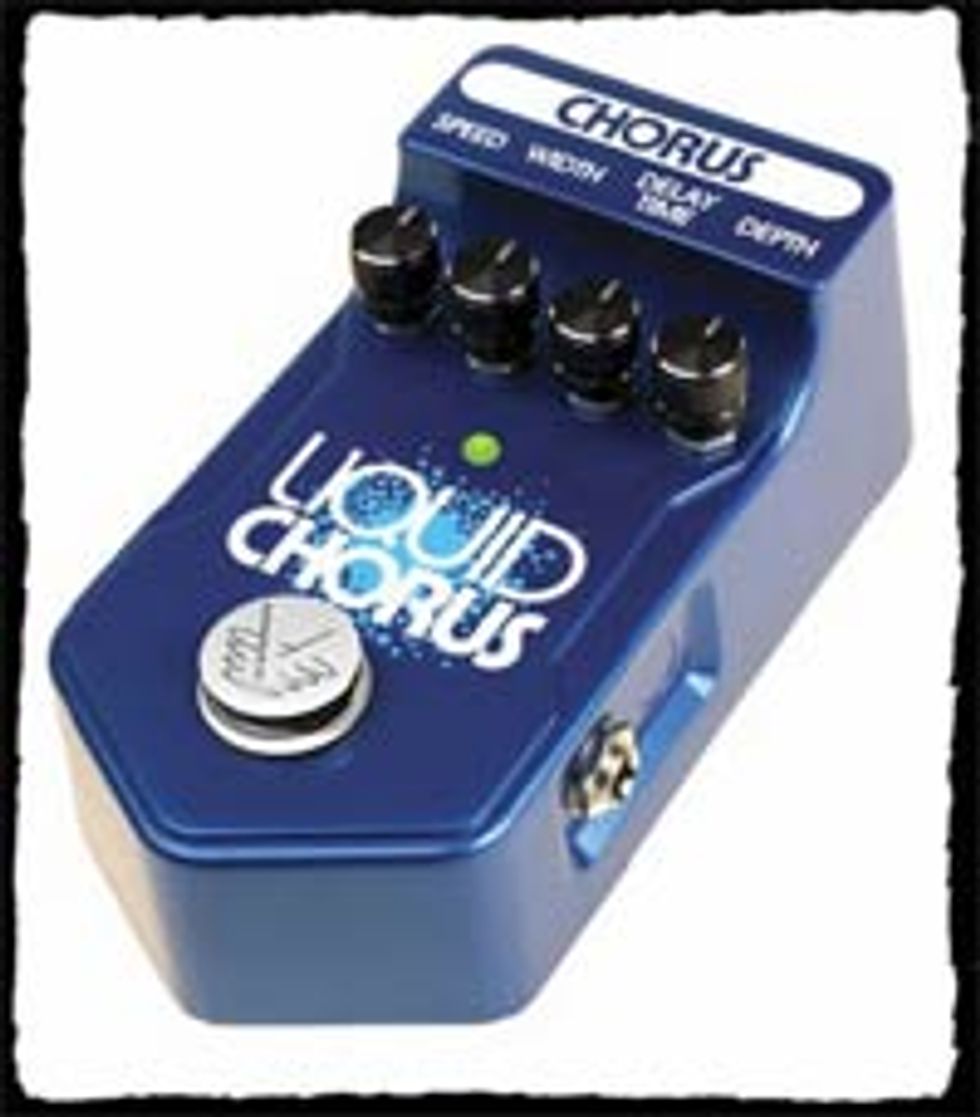 |
Visual Sound’s Liquid Chorus circuit uses analog Visual Sound “bucket brigade” chips, created using the same process as the legendary Panasonic Bucket Brigade Delay (BBD) chips. The fact that the company produces its own chips rather than using rare, expensive “New Old Stock” (NOS) allows Visual Sound to offer an analog chorus at a lower, more “digital” price.
Some chorus pedals offer only two controls, Speed and Depth. To these, Liquid Chorus adds Width and Delay Time. The Width knob thins or thickens out the chorus sound, while the Delay control sets the time of the delay sweep. All of this allows you to create a wide range of classic chorus effects. Unlike the H2O from which it is derived, the Liquid Chorus is “true stereo.” Rather than just emitting a dry signal, the second output emits a fullychorused sound, 180 degrees out of phase with the first output’s effect.
I found that cranking the depth and width with a shorter delay time recalled the lush top-forty sound of two decades ago. A longer delay time combined with a reduced width conjured up the EH Small Clone. Fiddling with the Speed and the other knobs created a variety of Leslietype effects. All I missed was a blend control that would allow me to add dry signal to the chorus.
The Liquid Chorus offers dead quiet operation, lots of low-end and rich analog sound. Combine this with a street price of under $150—in a market where some analog choruses top out in the $300 range—and you have a pedal that is a good bet for adding a world of swirl to your rig. – MR
Buy If...
you want a versatile, warm analog chorus.
Skip If...
you are “so over” chorus, or need a blend control.
Rating...
MSRP $207 - Visual Sound - visualsound.net |
Flanger
Hartman Analog Flanger
The Hartman Analog Flanger promises to be a faithful recreation of the old seventies EH Electric Mistress Flanger/Filter Matrix, based on a supply of the original chip type (SAD1024). Before plugging it in, I opened it up to inspect the build quality. The originals were poorly built and had lots of problems, but they did sound great when they worked. Based on my experience with other Hartman products, I was not surprised to see a well-laid-out circuit board with top-of-the-line construction techniques, along with quality carbon comp resistors and metal film caps. This should last a lifetime, unless you drop it off a building.
The unit has three knobs (Speed, Depth, Color), and a flange/filter switch, allowing you to stop the internal sweep generator and fix the pedal at any point in the sweep. The unit produced extremely clear, transparent flanging effects. Increasing the rate with the Depth down and a bit of Color gave a nice Leslie-type effect. With the Speed on a lower setting, I was able to get that smokey, mysterious flanging tone of the seventies. The Speed control has a very wide range, from super slow to a faster rate than many flangers. The Color knob is basically a regeneration control. At its maximum setting, it yielded the expected robotic sounds, but because of the impeccable quality of the unit I could not get a very good “And the Cradle Will Rock” tone—just not enough noise in the unit to do that well. It doesn’t sound like an MXR, but it’s not intended to. This is an extremely pleasing, and very musical sounding flanger. – KR
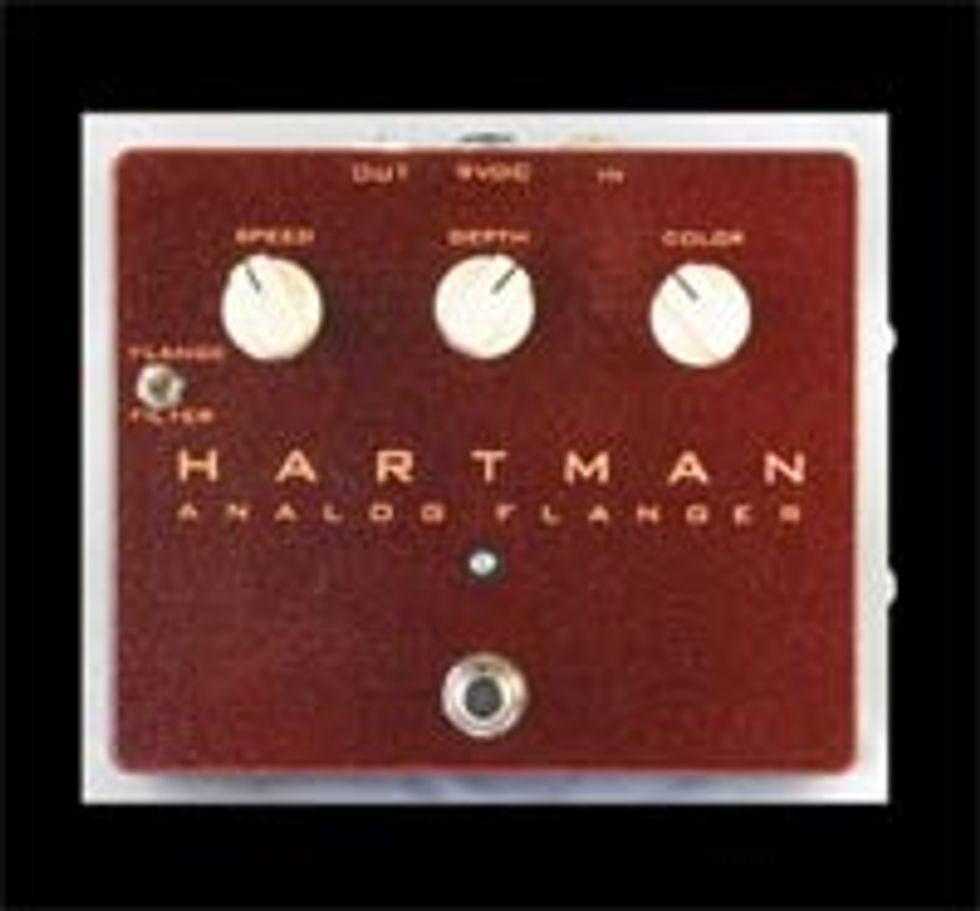 |
The Hartman Analog Flanger promises to be a faithful recreation of the old seventies EH Electric Mistress Flanger/Filter Matrix, based on a supply of the original chip type (SAD1024). Before plugging it in, I opened it up to inspect the build quality. The originals were poorly built and had lots of problems, but they did sound great when they worked. Based on my experience with other Hartman products, I was not surprised to see a well-laid-out circuit board with top-of-the-line construction techniques, along with quality carbon comp resistors and metal film caps. This should last a lifetime, unless you drop it off a building.
The unit has three knobs (Speed, Depth, Color), and a flange/filter switch, allowing you to stop the internal sweep generator and fix the pedal at any point in the sweep. The unit produced extremely clear, transparent flanging effects. Increasing the rate with the Depth down and a bit of Color gave a nice Leslie-type effect. With the Speed on a lower setting, I was able to get that smokey, mysterious flanging tone of the seventies. The Speed control has a very wide range, from super slow to a faster rate than many flangers. The Color knob is basically a regeneration control. At its maximum setting, it yielded the expected robotic sounds, but because of the impeccable quality of the unit I could not get a very good “And the Cradle Will Rock” tone—just not enough noise in the unit to do that well. It doesn’t sound like an MXR, but it’s not intended to. This is an extremely pleasing, and very musical sounding flanger. – KR
Buy If...
you’re looking for clear, sparkling flange tones.
Skip If...
you’re looking for more noise-based effects.
Rating...
MSRP $245 - Hartman Electronics - hartmanelectronicstore.com |
Compressor
Visual Sound V2 Comp 66
Since its introduction in 1999, fans of Visual Sound’s Route 66 stomp box have been requesting the compressor channel as a single pedal. They will cheer the release of Comp 66 as it enters the increasingly crowded field of compressor stompboxes.
Comp 66 has controls for gain and compression. There is no attack control—the attack time is slow at lower compression settings and gets faster as you turn up the Comp knob. I found cranking the Comp made it easy to get a full helping of Dyna Comp-like squeeze. Adding compression also increased sustain, evened out the volume of all the voices in a chord, and the level of the notes that I picked—more in the warm, uncolored style of a studio compressor than in the more obvious style of some stompboxes. Backing the compression control off allowed more attack through for a subtlety unobtainable with MXR and BOSS units.
The Visual Sound version also offers a tone control that can be switched on with a mini-toggle. With the tone control off, this is one of the most transparent pedal compressors I have ever heard—what goes in, comes out. Still, the tone control proved useful for adding treble to help funk chords cut, and to restore highs lost to long cables. Since you can back the compression control all the way off and use the Comp 66 as a clean boost, I found that turning the tone control down when I kicked in the pedal for solos helped fatten out Strat single coils.
With its transparency, warm sound, and many uses, the Comp 66 is set up nicely to compete with Keeley, Diamond and Demeter in the world of high-quality compressor pedals. – MR
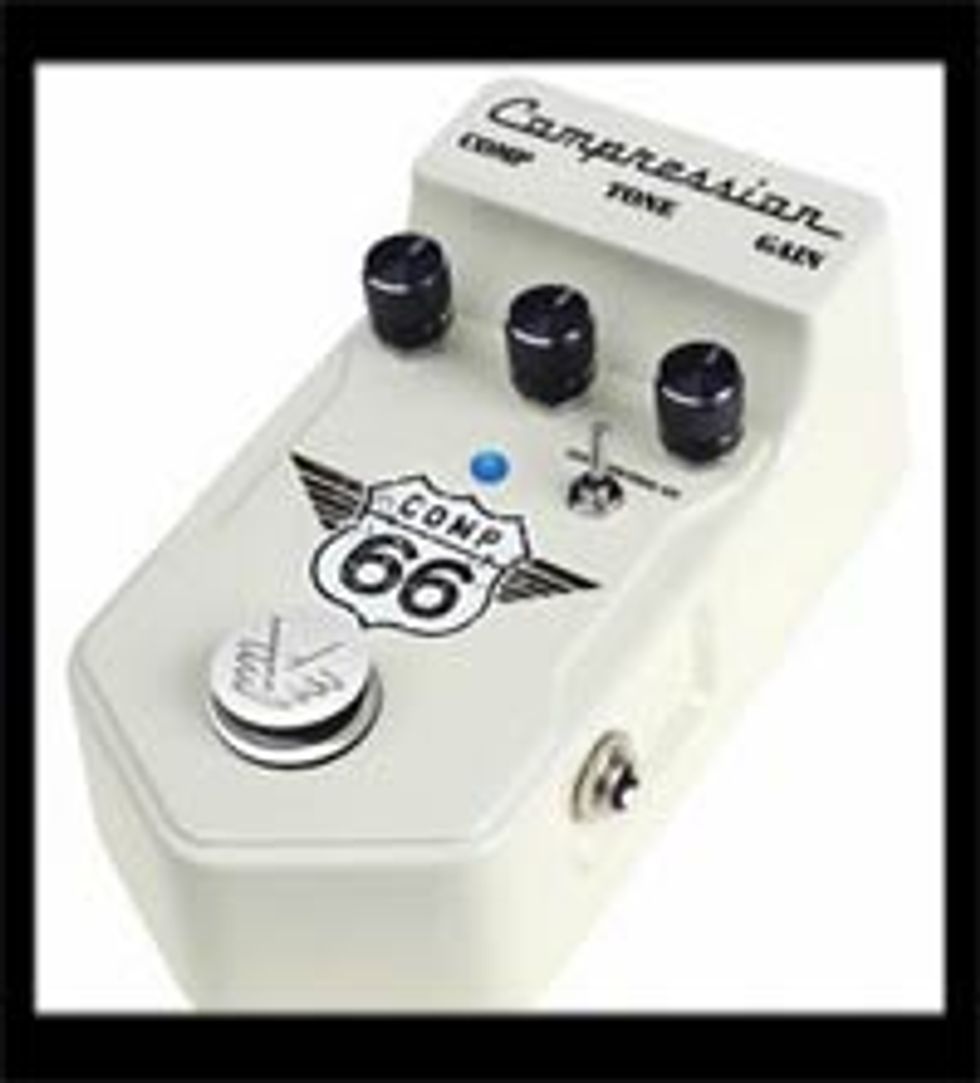 |
Since its introduction in 1999, fans of Visual Sound’s Route 66 stomp box have been requesting the compressor channel as a single pedal. They will cheer the release of Comp 66 as it enters the increasingly crowded field of compressor stompboxes.
Comp 66 has controls for gain and compression. There is no attack control—the attack time is slow at lower compression settings and gets faster as you turn up the Comp knob. I found cranking the Comp made it easy to get a full helping of Dyna Comp-like squeeze. Adding compression also increased sustain, evened out the volume of all the voices in a chord, and the level of the notes that I picked—more in the warm, uncolored style of a studio compressor than in the more obvious style of some stompboxes. Backing the compression control off allowed more attack through for a subtlety unobtainable with MXR and BOSS units.
The Visual Sound version also offers a tone control that can be switched on with a mini-toggle. With the tone control off, this is one of the most transparent pedal compressors I have ever heard—what goes in, comes out. Still, the tone control proved useful for adding treble to help funk chords cut, and to restore highs lost to long cables. Since you can back the compression control all the way off and use the Comp 66 as a clean boost, I found that turning the tone control down when I kicked in the pedal for solos helped fatten out Strat single coils.
With its transparency, warm sound, and many uses, the Comp 66 is set up nicely to compete with Keeley, Diamond and Demeter in the world of high-quality compressor pedals. – MR
Buy If...
you are looking for warm, variable, transparent compression.
Skip If...
you hate compression, or need an even smaller footprint
Rating...
MSRP $178 - Visual Sound - visualsound.net |
Boosts
Moollon Class A Boost
The very stylish, top-end Class A boost from Korean maker Geo Woo looks like it was designed by a tattoo artist turned silversmith; a peek inside reveals even more craftsmanship: clean point-to-point wiring and good quality components.
Instead of Gain or Volume controls, the Moollon offers only a three-stage transistor- based EQ (Lo, Mid, Hi) and an On/Off switch with LED indicator for straightforward tone-shaping simplicity. Many newer boosts based on the vintage units such as the Rangemaster offer a switching option for mid or bass boost. The Moollon’s three independent EQ controls, by contrast, each drive a select part of the frequency range. This makes it extremely versatile, since it’s essentially several different types of boost in one, but it allows you to blend the different types together to find just the right boosted tone.
With the Hi control on full by itself, the pedal sounds most like the vintage treble boosters that inspired it, putting a cutting edge on the tone and adding sparkle. The Mid boost fattens up my Strat’s single coils comfortably, without pushing the amp too hard or losing the clarity and bounce. The Lo control serves up a smooth, warm, slightly fuzzy boost that worked well with the neck P-90 on a Gibson LP BFG.
The Class A boost satisfies as both a clean boost and as a way to kick an already overdriven amp into a tasy harmonic crunch. Like a good boost should, the Moollon turns the guitar’s volume knob into something more like a gain control: rolling off cleans up the excess grit, while rolling it up increases sensitivity and responsiveness. Although it’s not vintage spec, it does deliver a particularly good “old school” tone—raw and energetic— with great harmonic content, sustain and definition. – CB
Dino’s Guitars Dynabox
Continuing their commitment to exceptional tone and craftsmanship, Alessio Casati and Andreas Bagnasco have created the Dino’s Dynabox, a hybrid booster designed to enhance the tonal and dynamic properties of your guitar. Like all Dino’s pedals, the Dynabox features a lightweight aluminum chassis, mixed PCB and point-to-point wiring and true bypass switching. The controls are a single Gain knob and a mini toggle switch that varies between a clean tone with a hint of compression and a bit of crunch.
Placed between a Vox AC30 and a recent Fender Stratocaster, with the gain set to 9 o’clock and the mini-toggle switch on the cleaner setting, the sound took on a nice compressed punch that worked great for both funk-style rhythm and country-style chicken picking. Switching the mini-toggle to its dirty side unleashed a nice hint of breakup that works great for classic rock and blues.
The Dynabox brings out the character in different instruments impressively. It reacted particularly well to single coiled instruments: a Strat, a reissue Telecaster, a ‘63 Dano Baritone, and even a vintage seventies Fender Musicmaster Bass. Unfortunately, the Dynabox was a little muddy when coupled with humbuckers, and wasn’t able to get completely clean in either setting. With a hair of treble boost on the amp, though, the lack of clean actually made for a nice alternative overdrive sound.
Though it’s a more dedicated pedal, the Dynabox could be a nice addition to your overall sound. If you’re looking for a booster with a lot of headroom and its own character, check it out. – SS
BSM RG (Rory Gallagher) Treble Booster
This pedal was developed to achieve the powerful sustaining punchy sound of the Strat played by Mr. Gallagher, who used it with a Rangemaster. Most models replicating the Rangemaster are basically the same circuit with a few mods to make them sound a bit more like the settings used by certain artists. In this case, the BSM Rory Gallagher model has a knob on the side labeled “volume,” but I found it boosted the upper mids into a really nice singing sustain. The originals did not have this feature. What is great about it is that by altering the position of the midrange either Strats or humbuckers will sound great. This particular model pedal seems to have a little extra tightness in the low end. I liked the definition and growl on those low notes—they were never muddy. It is best used before a distorting amp or a pedal, as are the other straight ahead Rangemaster-type models. I don’t think I would use it in front of a real clean amp like the Fender Twin, as it was just not that pleasing of a tone for me.
The RG is a well-constructed unit, as are all the BSM pedals I’ve had the privilege to test. True bypass switching is in place here. This pedal works great for pretty much all types of rock music, older and modern. It primarily sounds best for lead guitar and solo work, but it does clean up when the volume is backed down for a nice crunchy rhythm tone. – KR
BSM VX-C Treble Booster
This pedal is based on the Vox Treble and Bass booster. I happen to have an original one, and I found the BSM VX-C nearly identical to my original Vox pedal.
The VX-C actually boosts treble or brightness, along with the bass frequencies. It did not have a huge dB boost, but it did have enough to help push an amp into overdrive—a bit, but not massively. What is cool is that it can be used on clean or dirty settings of an amp, giving you several practical functions. On the clean side, it would be wonderful with a Rickenbacker 12-string, a la The Byrds and Tom Petty. Country players looking for that special sound when playing different registers of the neck will also appreciate this tone. My personal favorite use is with an amp that is already distorting. It should be used before a distortion or overdrive stompbox, so you can find that singing, driving tone a la David Gilmour. Used this way it provides an adjustable bite and sing with just a touch of the guitar’s volume control. I think the VX-C is a pretty cool thing for modern music as well because you can add definition without getting muddy. Because of the design of these pedals, you can overdrive the circuit with a hotter humbucker, so be aware that this may be good or bad, depending on what you’re doing. The pedal design incorporates a smart tone control mounted on the side, which allows you to attenuate and define your own sound. – KR
BSM RPA Treble Booster
Another entry from the workshop of mad scientist/tone historian Bernd Meiser, the RPA (which stands for Richie’s Pre Amp) emulates Richie Blackmore’s post-1974 sound: an AIWA TP-1011 reel-to-reel tape recorder’s preamp and a heavily hot-rodded Marshall Major 200.
The RPA has both Gain and EQ controls to help compensate for different amp and pickup combinations, allowing you to achieve that very specific target tone without having to use exactly the same gear. Though the distinction between pre- and post-1974 Blackmore might be too fine for many players, it’s easy to appreciate the dedication to detail that went into making this pedal. It sent me rummaging through an old box of cassette tapes to find some late Purple and some early Rainbow, and it made me want to see if I could emulate that tone with an LP Studio and a modeling amp. I can’t say if I was entirely successful, but I learned some things for having tried—and it was fun. If this is not the BSM boost for you, find the one that is and buy it. – CB
Lizard Leg Flying Dragon
Hand built by Steve Miller (not that Steve Miller) in Gonzales, Louisiana, the Flying Dragon is housed in a sturdy, customlabeled enclosure with a cool graphic and a very small footprint. Made of top-quality components, the Dragon is true bypass, noiseless, and dead simple—one big, toefriendly knob.
The real strength of this pedal is in its balance and transparency. It offers a single stage, broad frequency boost to give your tube amp a serious front-end push. If you just need more volume for clean leads and solos, and you want to preserve the essential tone of your rig, the Dragon’s transparency makes it a very good pick. Up to about noon, it made my Tele’s single coils sound beefier through several different amps, but with no extra brightness, midrange hump, or loss of clarity on the low end.
If you’re looking for a boost that you can leave on, turn the Dragon up past noon—it’ll kick a clean amp into a bit of a sweat, giving your signal more sparkle and animation, while providing a touch of grit when you dig in. It’s very sensitive, and responds admirably to changes in playing dynamics. For a real kick, use it to push an amp that’s already working overtime into some sweet, rich clipping. At 13dB of overall boost, the Dragon is less extravagant than many other similar pedals, but it doesn’t seem to need any more.
Also worthy of special mention, Lizard Leg sent us “The Box.” It’s a small, standalone 9V DC adaptor that runs on batteries. With no more unscrewing every enclosure for battery access, and no need to find a spot for another wall wart, it made the job of reviewing a big pile of pedals much simpler. It is sold separately, but at only $15 when you order a pedal it’s a nobrainer. – CB
Demeter MB-2B Fat Control Mid Boost/Buffer
Achieving the long, violin-like sustain of a Les Paul is an uphill battle for many players. To achieve this sound without the aid of the infamous Gibson, guitarists have employed an array of techniques and effects, such as compressor, sustainer, and booster pedals. The downside is that the outcome is often an overly distorted or “woofy” tone, and at times, a loss of the special characteristics of the instrument that the player fell in love with in the first place.
With an extensive background in amplifier and effect design, Demeter Amplification introduced the Fat Control Mid Boost/ Buffer pedal. The objective was to isolate the natural midrange frequencies of the guitar, and give the player a way to shape those frequencies without losing the chime, cut and characteristics of a good set of pickups (specifically in this case, single coils). It has only one control knob that allows you to go from a flat midrange frequency to a very pronounced mid hump. Using a G&L ASAT Classic into the clean channel of a Crate V33H tube half stack yielded a very natural, smooth sustain that was very impressive. The notes blossomed with less effort, and digging into the strings didn’t cause any noticeable, unwanted distortion. Unable to resist the urge to try it with humbuckers, I grabbed my 1978 Les Paul Custom with Tom Anderson pickups and pushed the half stack into a nice sweet spot for classic rock with the pedal in bypass mode. Activating the pedal with the control at noon caused the amp to seep killer smooth distorted tones, like T. Rex’s The Slider on steroids. However, beyond the 12 o’clock position with humbuckers the tone muddied up a bit, so backing off of the gain at that point was a good idea.
The Demeter Fat Control is a great addition to any guitarist’s arsenal, especially if you’ve been struggling with cutting through the mix. The price is in line with its competitors, it’s simple to use, and takes up very little real estate on your pedalboard. – JW
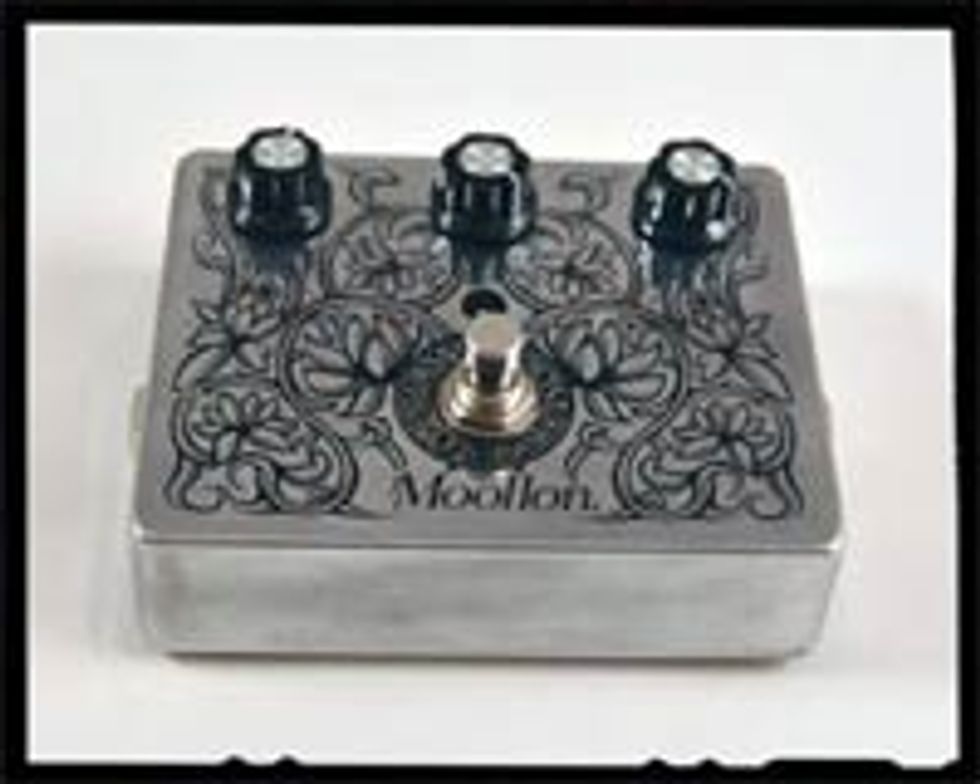 | |
| Download example 1 Boost: Lo, Mid, Hi all at 2:00 | |
| Recorded in Sound Studio on a MacBook Pro using a Digidesign Mbox (SM57); Vox AD120VT modeling an AC30TB; Fender Contemporary Tele, neck pup S/C; reverb added. | |
The very stylish, top-end Class A boost from Korean maker Geo Woo looks like it was designed by a tattoo artist turned silversmith; a peek inside reveals even more craftsmanship: clean point-to-point wiring and good quality components.
Instead of Gain or Volume controls, the Moollon offers only a three-stage transistor- based EQ (Lo, Mid, Hi) and an On/Off switch with LED indicator for straightforward tone-shaping simplicity. Many newer boosts based on the vintage units such as the Rangemaster offer a switching option for mid or bass boost. The Moollon’s three independent EQ controls, by contrast, each drive a select part of the frequency range. This makes it extremely versatile, since it’s essentially several different types of boost in one, but it allows you to blend the different types together to find just the right boosted tone.
With the Hi control on full by itself, the pedal sounds most like the vintage treble boosters that inspired it, putting a cutting edge on the tone and adding sparkle. The Mid boost fattens up my Strat’s single coils comfortably, without pushing the amp too hard or losing the clarity and bounce. The Lo control serves up a smooth, warm, slightly fuzzy boost that worked well with the neck P-90 on a Gibson LP BFG.
The Class A boost satisfies as both a clean boost and as a way to kick an already overdriven amp into a tasy harmonic crunch. Like a good boost should, the Moollon turns the guitar’s volume knob into something more like a gain control: rolling off cleans up the excess grit, while rolling it up increases sensitivity and responsiveness. Although it’s not vintage spec, it does deliver a particularly good “old school” tone—raw and energetic— with great harmonic content, sustain and definition. – CB
Buy If...
you want a vintage-sounding boost with lots of tone-shaping versatility.
Skip If...
your shit-kickers are always covered in mud.
Rating...
MSRP $439 - Moollon - moollon.com |
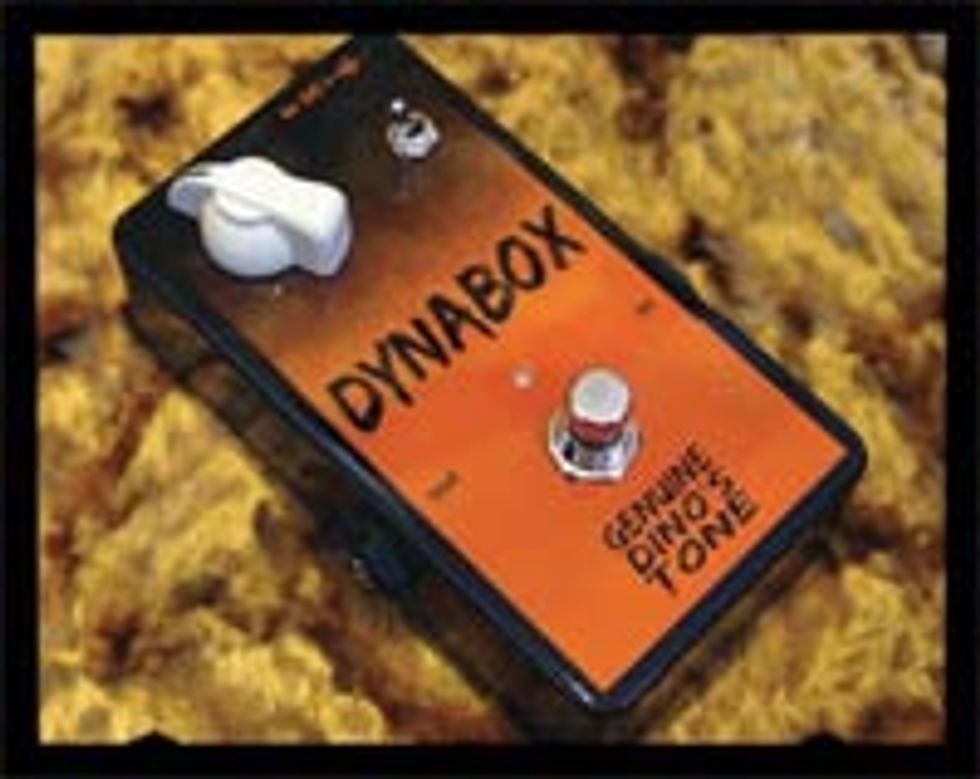 | |
| Download example 1 | |
| Recorded with a Burns Steer Cutaway and a Fender Deluxe | |
Continuing their commitment to exceptional tone and craftsmanship, Alessio Casati and Andreas Bagnasco have created the Dino’s Dynabox, a hybrid booster designed to enhance the tonal and dynamic properties of your guitar. Like all Dino’s pedals, the Dynabox features a lightweight aluminum chassis, mixed PCB and point-to-point wiring and true bypass switching. The controls are a single Gain knob and a mini toggle switch that varies between a clean tone with a hint of compression and a bit of crunch.
Placed between a Vox AC30 and a recent Fender Stratocaster, with the gain set to 9 o’clock and the mini-toggle switch on the cleaner setting, the sound took on a nice compressed punch that worked great for both funk-style rhythm and country-style chicken picking. Switching the mini-toggle to its dirty side unleashed a nice hint of breakup that works great for classic rock and blues.
The Dynabox brings out the character in different instruments impressively. It reacted particularly well to single coiled instruments: a Strat, a reissue Telecaster, a ‘63 Dano Baritone, and even a vintage seventies Fender Musicmaster Bass. Unfortunately, the Dynabox was a little muddy when coupled with humbuckers, and wasn’t able to get completely clean in either setting. With a hair of treble boost on the amp, though, the lack of clean actually made for a nice alternative overdrive sound.
Though it’s a more dedicated pedal, the Dynabox could be a nice addition to your overall sound. If you’re looking for a booster with a lot of headroom and its own character, check it out. – SS
Buy If...
you want a booster with a lot of headroom and a little bit of grit.
Skip If...
you need a booster that gets super clean.
Rating...
MSRP $170 - Dino’s Guitars - dinosguitars.com |
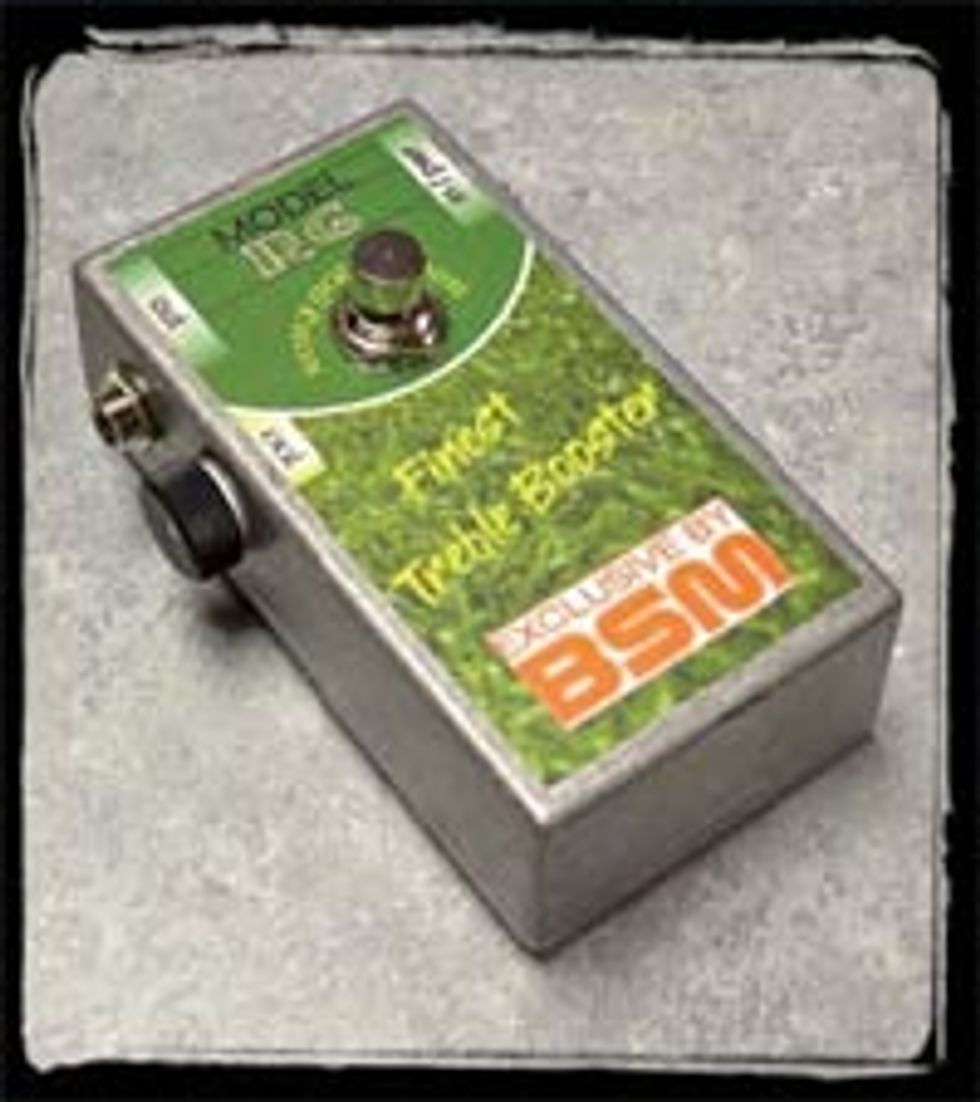 |
This pedal was developed to achieve the powerful sustaining punchy sound of the Strat played by Mr. Gallagher, who used it with a Rangemaster. Most models replicating the Rangemaster are basically the same circuit with a few mods to make them sound a bit more like the settings used by certain artists. In this case, the BSM Rory Gallagher model has a knob on the side labeled “volume,” but I found it boosted the upper mids into a really nice singing sustain. The originals did not have this feature. What is great about it is that by altering the position of the midrange either Strats or humbuckers will sound great. This particular model pedal seems to have a little extra tightness in the low end. I liked the definition and growl on those low notes—they were never muddy. It is best used before a distorting amp or a pedal, as are the other straight ahead Rangemaster-type models. I don’t think I would use it in front of a real clean amp like the Fender Twin, as it was just not that pleasing of a tone for me.
The RG is a well-constructed unit, as are all the BSM pedals I’ve had the privilege to test. True bypass switching is in place here. This pedal works great for pretty much all types of rock music, older and modern. It primarily sounds best for lead guitar and solo work, but it does clean up when the volume is backed down for a nice crunchy rhythm tone. – KR
Buy If...
you’re after the most killer snarling Strat tone ever, or a really aggressive humbucker sound.
Skip If...
you’re looking for more of a Stevie Ray tone.
Rating...
MSRP $319.99 - BSM - treblebooster.net |
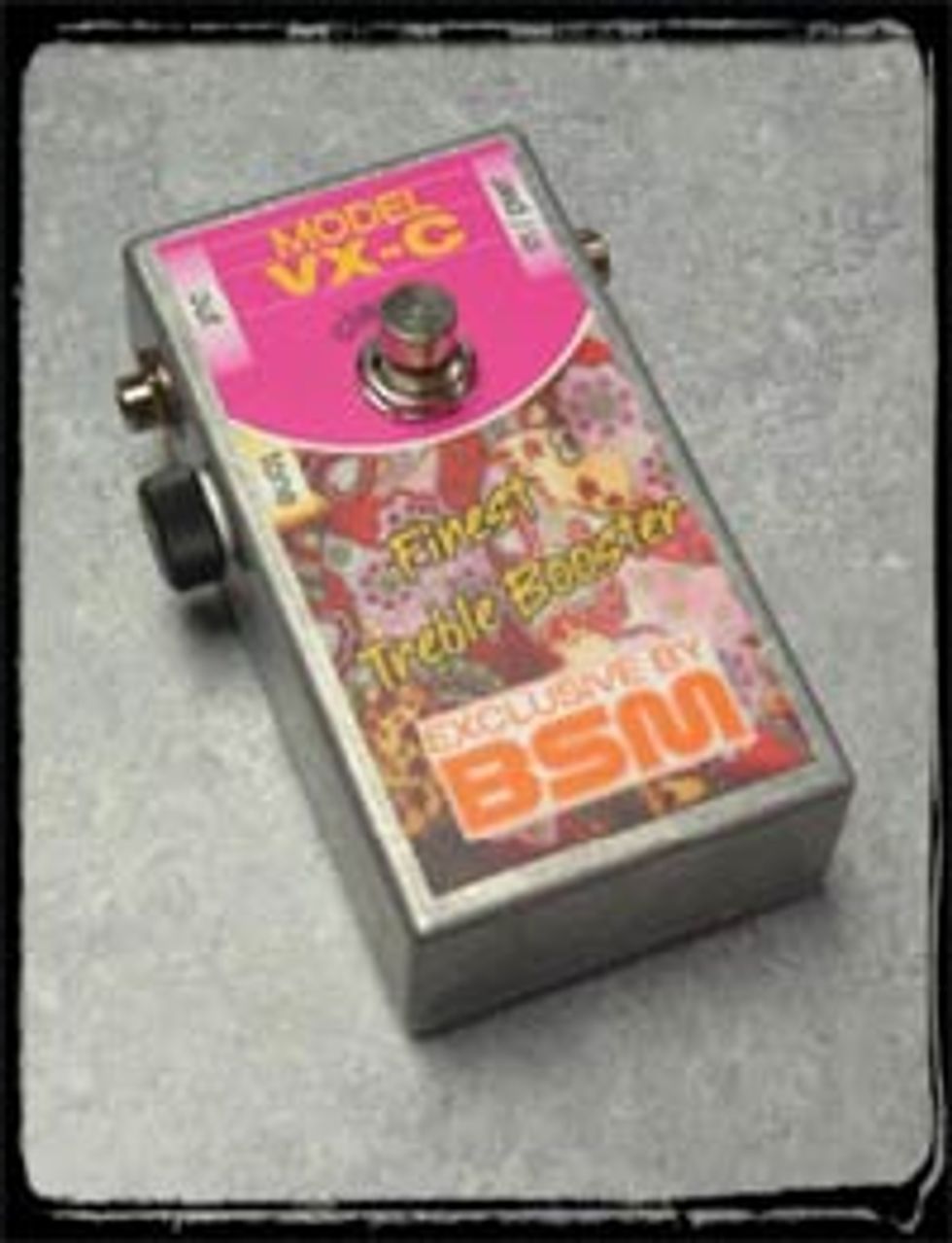 |
This pedal is based on the Vox Treble and Bass booster. I happen to have an original one, and I found the BSM VX-C nearly identical to my original Vox pedal.
The VX-C actually boosts treble or brightness, along with the bass frequencies. It did not have a huge dB boost, but it did have enough to help push an amp into overdrive—a bit, but not massively. What is cool is that it can be used on clean or dirty settings of an amp, giving you several practical functions. On the clean side, it would be wonderful with a Rickenbacker 12-string, a la The Byrds and Tom Petty. Country players looking for that special sound when playing different registers of the neck will also appreciate this tone. My personal favorite use is with an amp that is already distorting. It should be used before a distortion or overdrive stompbox, so you can find that singing, driving tone a la David Gilmour. Used this way it provides an adjustable bite and sing with just a touch of the guitar’s volume control. I think the VX-C is a pretty cool thing for modern music as well because you can add definition without getting muddy. Because of the design of these pedals, you can overdrive the circuit with a hotter humbucker, so be aware that this may be good or bad, depending on what you’re doing. The pedal design incorporates a smart tone control mounted on the side, which allows you to attenuate and define your own sound. – KR
Buy If...
you’re looking for more definition and bite to your guitar tone, or you’ve always wanted a Vox TB Booster.
Skip If...
you’re looking for an EQ-type pedal.
Rating...
MSRP $269.99 - BSM - treblebooster.net |
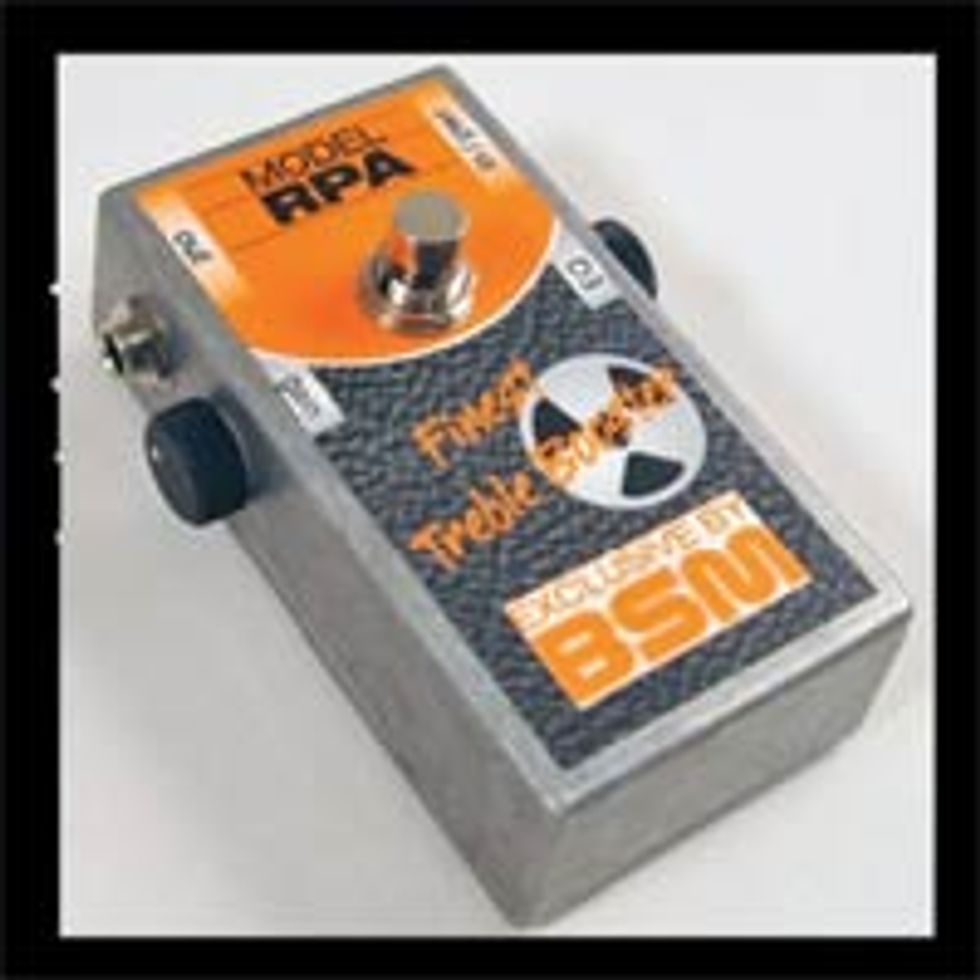 |
Another entry from the workshop of mad scientist/tone historian Bernd Meiser, the RPA (which stands for Richie’s Pre Amp) emulates Richie Blackmore’s post-1974 sound: an AIWA TP-1011 reel-to-reel tape recorder’s preamp and a heavily hot-rodded Marshall Major 200.
The RPA has both Gain and EQ controls to help compensate for different amp and pickup combinations, allowing you to achieve that very specific target tone without having to use exactly the same gear. Though the distinction between pre- and post-1974 Blackmore might be too fine for many players, it’s easy to appreciate the dedication to detail that went into making this pedal. It sent me rummaging through an old box of cassette tapes to find some late Purple and some early Rainbow, and it made me want to see if I could emulate that tone with an LP Studio and a modeling amp. I can’t say if I was entirely successful, but I learned some things for having tried—and it was fun. If this is not the BSM boost for you, find the one that is and buy it. – CB
Buy If...
you’re all about the Blackmore.
Skip If...
there’s another BSM pedal calling your name.
Rating...
MSRP $479.99 - BSM - treblebooster.net |
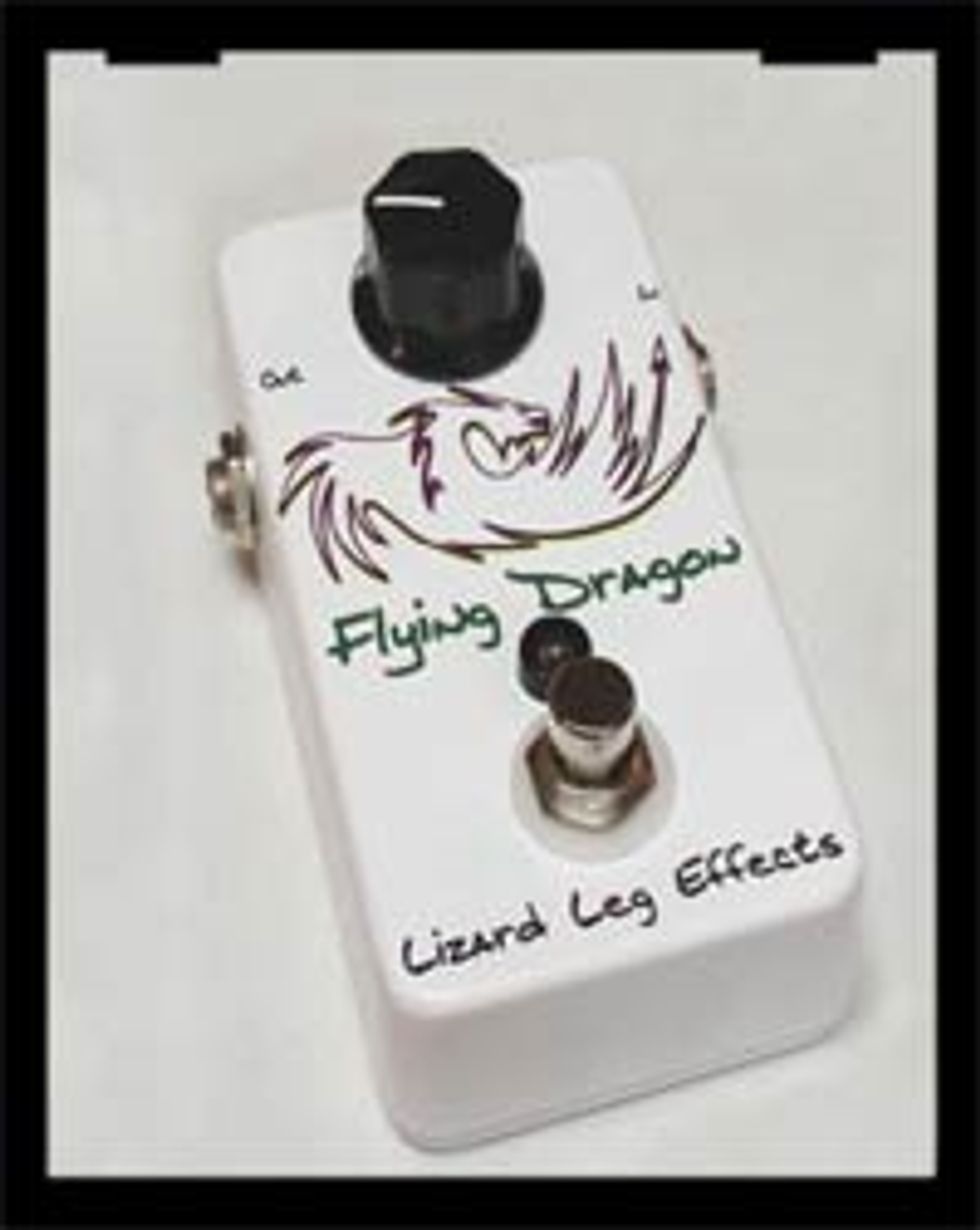 |
Hand built by Steve Miller (not that Steve Miller) in Gonzales, Louisiana, the Flying Dragon is housed in a sturdy, customlabeled enclosure with a cool graphic and a very small footprint. Made of top-quality components, the Dragon is true bypass, noiseless, and dead simple—one big, toefriendly knob.
The real strength of this pedal is in its balance and transparency. It offers a single stage, broad frequency boost to give your tube amp a serious front-end push. If you just need more volume for clean leads and solos, and you want to preserve the essential tone of your rig, the Dragon’s transparency makes it a very good pick. Up to about noon, it made my Tele’s single coils sound beefier through several different amps, but with no extra brightness, midrange hump, or loss of clarity on the low end.
If you’re looking for a boost that you can leave on, turn the Dragon up past noon—it’ll kick a clean amp into a bit of a sweat, giving your signal more sparkle and animation, while providing a touch of grit when you dig in. It’s very sensitive, and responds admirably to changes in playing dynamics. For a real kick, use it to push an amp that’s already working overtime into some sweet, rich clipping. At 13dB of overall boost, the Dragon is less extravagant than many other similar pedals, but it doesn’t seem to need any more.
Also worthy of special mention, Lizard Leg sent us “The Box.” It’s a small, standalone 9V DC adaptor that runs on batteries. With no more unscrewing every enclosure for battery access, and no need to find a spot for another wall wart, it made the job of reviewing a big pile of pedals much simpler. It is sold separately, but at only $15 when you order a pedal it’s a nobrainer. – CB
Buy If...
you want a muscular, well-built boost that won’t add its own signature to your tone.
Skip If...
you’re looking to boost a specific frequency range.
Rating...
MSRP $179 (US delivery) - Lizard Leg Effects - lizardlegeffects.com |
 |
Achieving the long, violin-like sustain of a Les Paul is an uphill battle for many players. To achieve this sound without the aid of the infamous Gibson, guitarists have employed an array of techniques and effects, such as compressor, sustainer, and booster pedals. The downside is that the outcome is often an overly distorted or “woofy” tone, and at times, a loss of the special characteristics of the instrument that the player fell in love with in the first place.
With an extensive background in amplifier and effect design, Demeter Amplification introduced the Fat Control Mid Boost/ Buffer pedal. The objective was to isolate the natural midrange frequencies of the guitar, and give the player a way to shape those frequencies without losing the chime, cut and characteristics of a good set of pickups (specifically in this case, single coils). It has only one control knob that allows you to go from a flat midrange frequency to a very pronounced mid hump. Using a G&L ASAT Classic into the clean channel of a Crate V33H tube half stack yielded a very natural, smooth sustain that was very impressive. The notes blossomed with less effort, and digging into the strings didn’t cause any noticeable, unwanted distortion. Unable to resist the urge to try it with humbuckers, I grabbed my 1978 Les Paul Custom with Tom Anderson pickups and pushed the half stack into a nice sweet spot for classic rock with the pedal in bypass mode. Activating the pedal with the control at noon caused the amp to seep killer smooth distorted tones, like T. Rex’s The Slider on steroids. However, beyond the 12 o’clock position with humbuckers the tone muddied up a bit, so backing off of the gain at that point was a good idea.
The Demeter Fat Control is a great addition to any guitarist’s arsenal, especially if you’ve been struggling with cutting through the mix. The price is in line with its competitors, it’s simple to use, and takes up very little real estate on your pedalboard. – JW
Buy If...
you need a boost that can push you back into the mix without losing clarity and definition.
Skip If...
you need a boost that emphasizes any other frequencies, such as low and high end.
Rating...
MSRP $219 - Demeter Amplification - demeteramps.com |
Tremolo/Rotary
DLS Effects RotoSIM
I spent some time this past summer looking around for a good Leslie-type effect for my stage rig—not a Uni-Vibe or something like that (although there are plenty of good ones out there), but something that would get me close to real rotary speaker sound, without me having to lug around another heavy cabinet. I wanted a unit that offered fine control over all the different aspects of an authentic Leslie speaker unit, and could give me stereo output, but didn’t sound canned. I found some good-sounding gear, but nothing really enticed me.
Then the DLS RotoSIM came across my desk, and I have to say that while it didn’t light me on fire, it does have everything I was looking for—and a real shot at finding a spot on my pedalboard. For starters, it’s got individual horn intensity controls for Bass and Tweeter, independent rotation speed knobs, ramp time control and a footswitch to toggle between fast and slow settings—all necessary features in my book. In addition, there is a built-in overdrive with an On/Off switch and gain control. At high gain, the overdrive clipping is a little harsh for my taste, but it’s quite good if you just want to throw a bit of dirt in there.
Stereo output is also a must-have option for truly convincing Leslie swirl. The DLS’s stereo output feature goes even further, as it provides two separate inputs. Use the stereo input and get a lush, even spread from the dual outputs; or, use the other input and the two outputs then offer slightly different tonalities for you to choose from. In this setup, Output A is more transparent, as advertised. Output B is thicker sounding, and seems to have greater presence. If these or any of the other tonal elements don’t suit your liking, there are seven internal trim pots for extra-tweakable volume, gain, blend, response—everything. I played this unit through several different guitar/amp combinations, mono and stereo, and I was very pleased with the way it handled everything I did. – CB
Seymour Duncan SFX-07 Shape Shifter
This tap tremolo was made to reproduce the rich classic tremolo sound of vintage fifties tube amps, but the Shape Shifter also offers new parameter controls to make your tremolo do things those amps could never do—warble, sputter, flutter, even a helicopter chop. Some settings approach a filter effect vibe, and others even sound like delay.
The unit comes in 16-gauge steel housing with bypass and digital tap tempo switches, and uses a pure analog signal path. Control knobs are large but not quite “toe-tweakable” size. The Depth control, at the heart of the traditional tremolo sound, has a wide range that goes smoothly from subtle to pulsing tremolo; the Wave control offers continuous waveform variation, from sine to triangle to square.
The unique Shape control for which the pedal is named is a very cool feature, allowing you to control the ratio of volume swell to decrease, enabling the creation of very appealing envelope-type sounds, from percussive and piano-like chimes to backward-sounding pulses. The Rate knob works in two modes: in rate mode, it is a speed control that goes from 1 to 20 cycles per second. In ratio mode, the Rate knob controls the tap-to-note ratio, while the tempo is set by the tap switch.
The sound was indeed lush, and gave me no noise. I had a lot fun dialing all types of effects, some of which were truly inspiring. This is much more than a tremolo. – CB
 |
I spent some time this past summer looking around for a good Leslie-type effect for my stage rig—not a Uni-Vibe or something like that (although there are plenty of good ones out there), but something that would get me close to real rotary speaker sound, without me having to lug around another heavy cabinet. I wanted a unit that offered fine control over all the different aspects of an authentic Leslie speaker unit, and could give me stereo output, but didn’t sound canned. I found some good-sounding gear, but nothing really enticed me.
Then the DLS RotoSIM came across my desk, and I have to say that while it didn’t light me on fire, it does have everything I was looking for—and a real shot at finding a spot on my pedalboard. For starters, it’s got individual horn intensity controls for Bass and Tweeter, independent rotation speed knobs, ramp time control and a footswitch to toggle between fast and slow settings—all necessary features in my book. In addition, there is a built-in overdrive with an On/Off switch and gain control. At high gain, the overdrive clipping is a little harsh for my taste, but it’s quite good if you just want to throw a bit of dirt in there.
Stereo output is also a must-have option for truly convincing Leslie swirl. The DLS’s stereo output feature goes even further, as it provides two separate inputs. Use the stereo input and get a lush, even spread from the dual outputs; or, use the other input and the two outputs then offer slightly different tonalities for you to choose from. In this setup, Output A is more transparent, as advertised. Output B is thicker sounding, and seems to have greater presence. If these or any of the other tonal elements don’t suit your liking, there are seven internal trim pots for extra-tweakable volume, gain, blend, response—everything. I played this unit through several different guitar/amp combinations, mono and stereo, and I was very pleased with the way it handled everything I did. – CB
Buy If...
you’re looking for a versatile, authentic-sounding rotary effect with stereo output
Skip If...
you’ve got the roadies to haul your vintage Leslie cabs.
Rating...
MSRP $299 - DLS Effects - dlseffects.com |
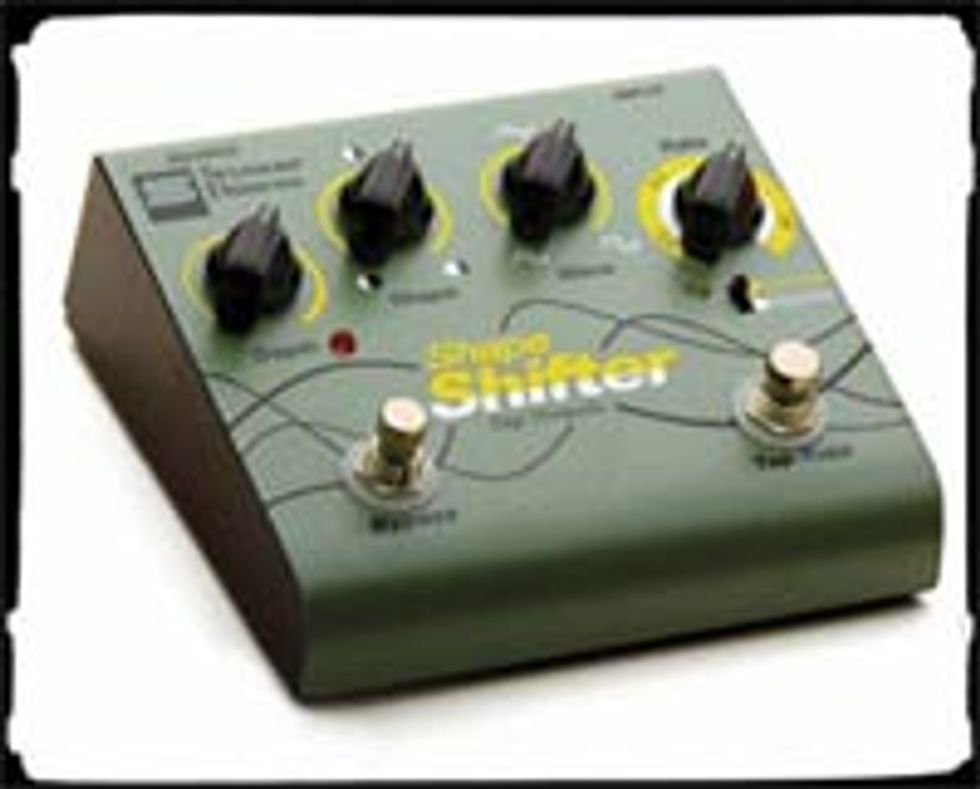 | |
| Download example 1 British Trem; Helicopter; Backward Trem; Faux Piano | |
| Recorded in Sound Studio on a MacBook Pro using Digidesign Mbox (SM57); Vox AD120VT modeling Marshall Super Lead; Fender Contemp. Tele, both pups S/C. | |
This tap tremolo was made to reproduce the rich classic tremolo sound of vintage fifties tube amps, but the Shape Shifter also offers new parameter controls to make your tremolo do things those amps could never do—warble, sputter, flutter, even a helicopter chop. Some settings approach a filter effect vibe, and others even sound like delay.
The unit comes in 16-gauge steel housing with bypass and digital tap tempo switches, and uses a pure analog signal path. Control knobs are large but not quite “toe-tweakable” size. The Depth control, at the heart of the traditional tremolo sound, has a wide range that goes smoothly from subtle to pulsing tremolo; the Wave control offers continuous waveform variation, from sine to triangle to square.
The unique Shape control for which the pedal is named is a very cool feature, allowing you to control the ratio of volume swell to decrease, enabling the creation of very appealing envelope-type sounds, from percussive and piano-like chimes to backward-sounding pulses. The Rate knob works in two modes: in rate mode, it is a speed control that goes from 1 to 20 cycles per second. In ratio mode, the Rate knob controls the tap-to-note ratio, while the tempo is set by the tap switch.
The sound was indeed lush, and gave me no noise. I had a lot fun dialing all types of effects, some of which were truly inspiring. This is much more than a tremolo. – CB
Buy If...
traditional tremolo effects bore you.
Skip If...
you’d much rather stay bored.
Rating...
MSRP $225 - Seymour Duncan - seymourduncan.com |
Overdrives
Himmelstrutz Elektro Art Fetto
When I opened the box containing the Fetto, handmade by Swedish tonehound C.J. Himmelstrutz, the gonzo style of the type and graphic immediately reminded me of a Ralph Steadman design. The association led me to expect a brash, cheeky, high-brow-meets-low-brow attitude, and the Fetto didn’t disappoint.
An overdrive/distortion with an amp-like feel, the Fetto has a Plexi-like gain structure with a wide range of Drive control, great clarity and string definition even at high gain, and nice harmonic complexity even at low gain. More transparent than TS-style pedals tonally, with less apparent compression, the Fetto has a unique flair that seems a lot like a cross between a fuzz and overdrive. Although its attack is smoother than a characteristic fuzz, the tone is loose and undisciplined up into the mids; the mids are tight but vowelly, and the top end tightens into a defined crunch with rich, singing sustain. The Fetto does not fatten single coils or add a lot of coloration to your basic tone, so the rig you’re using still sounds like your rig, but it really does well at delivering a raw, driven, articulate sound.
The Fetto also features true bypass, a bright blue LED, a small footprint, and a rock solid (and very heavy) case. If you’re an unrepentant tone tweaker, you’ll love that the fact that the Fetto also offers four internal trim pots for even more fine control over the pedal’s full range of tone potential. – CB
Dino’s Guitars Rust Box
Italians have always seemed to possess a knack for luxury and a hint of the exotic. It is apparent in the vision of Alessio Casati and Andreas Bagnasco, the luthier duo of Dino’s Guitars. The long-time friends from Savona, Italy have dedicated themselves to the Italian tradition of craftsmanship manufacturing custom guitars, speaker cabinets, and hand-wired pedals since 1995. Dino’s Guitars Rust Box overdrive/distortion is the flagship of their pedal line. It’s housed in a lightweight aluminum chassis and assembled using a mix of PCB and point-to-point construction. Features include dedicated Bass and Treble knobs, as well as Drive/Gain and Master Volume controls. There is also a three way mini toggle switch that selects between three distinct levels of distortion for a nearly endless combination of distortion types, ranging from just a hint of crunch to a flat-out searing drive that any metal junkie would love.
Rigorously tested with numerous guitars and amps, the Rust Box showed great diversity: it performed exceptionally well with single coil pickups on a Fender Stratocaster, a Dano ’63 Reissue, and a Burns Steer Cutaway, all through a Fender Deluxe. The Rust Box also worked well on a ‘73 Fender Jazz Bass and an early-seventies Hagstrom Swede bass. The Treble and Bass knobs helped tailor the Rust Box to each instrument without over-coloring the instrument’s personal character.
All in all, the Rust Box is a very well built overdrive/distortion pedal capable of a great variety of flavors. If you are looking for an all-purpose box, it definitely warrants a closer look. – SS
Geek MacDaddy British Ball Breaker
Professional musicians make their living by their tone, and no one knows it better than L.A. sideman Jeff Rubin, who’s shared the stage with artists like Oingo Boingo, Randy Jackson, and Chuck Berry. Jeff’s quest for tone led him to manufacturing his own hand-built pedals and Geek MacDaddy was born.
The latest offering is the British Ball Breaker overdrive/distortion, featuring a powder-coated aluminum chassis displaying Britain’s flag beside a jovial Rubin in guard’s uniform. The Ball Breaker uses Burr Brown opamps along with Wima, AVX, and Nichicon capacitors. The true bypass pedal also features Gain, Presence, Tone, and Volume controls for a number of tonal possibilities.
Keeping with British tradition, the Ball Breaker was tested with a Burns Steer Cutaway into the AC30-inspired Top Gain module of a Randall RM50. With Gain, Presence, and Tone all set at 12 o’clock, the Ball Breaker immediately nailed that classic British distortion reminiscent of Brian May or Jimmy Page. Adding some of the Ball Breaker’s Presence knob changed the character completely, leaning now more toward a Marshall-type tone, especially with the tone knob cranked.
Geek MacDaddy’s Ball Breaker is a great option for players looking for a warm, organic-sounding pedal. It responds like it’s actually part of your amp instead of a separate pedal. It may not be versatile enough for players in other genres like metal, but if you need classic overdrive this may be the box for you. – SS
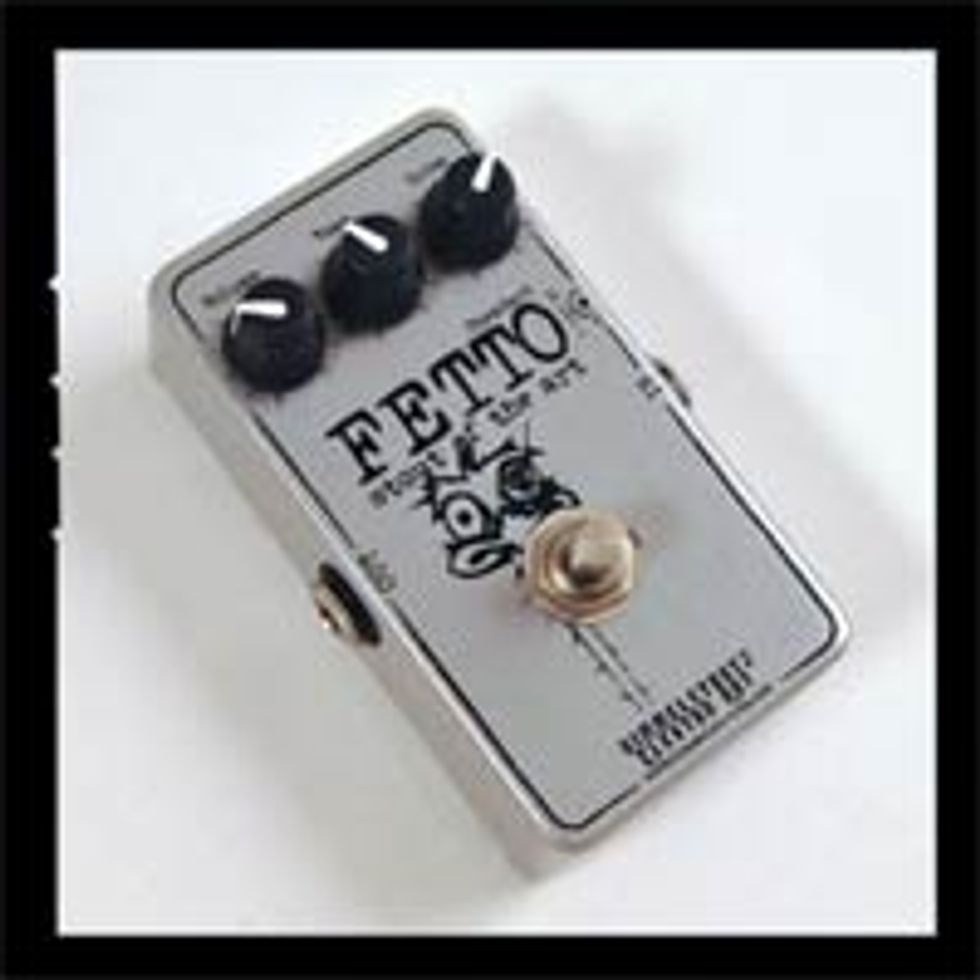 | |
| Download example 1 All settings around noon | |
| Download example 2 Volume at 10:00, Tone at 11:00, Drive at 1:30 | |
| Recorded in Sound Studio on a MacBook Pro using Digidesign Mbox (SM57); Vox AD120VT modeling Marshall Super Lead; Fender Contemporary Telecaster, bridge HB. | |
When I opened the box containing the Fetto, handmade by Swedish tonehound C.J. Himmelstrutz, the gonzo style of the type and graphic immediately reminded me of a Ralph Steadman design. The association led me to expect a brash, cheeky, high-brow-meets-low-brow attitude, and the Fetto didn’t disappoint.
An overdrive/distortion with an amp-like feel, the Fetto has a Plexi-like gain structure with a wide range of Drive control, great clarity and string definition even at high gain, and nice harmonic complexity even at low gain. More transparent than TS-style pedals tonally, with less apparent compression, the Fetto has a unique flair that seems a lot like a cross between a fuzz and overdrive. Although its attack is smoother than a characteristic fuzz, the tone is loose and undisciplined up into the mids; the mids are tight but vowelly, and the top end tightens into a defined crunch with rich, singing sustain. The Fetto does not fatten single coils or add a lot of coloration to your basic tone, so the rig you’re using still sounds like your rig, but it really does well at delivering a raw, driven, articulate sound.
The Fetto also features true bypass, a bright blue LED, a small footprint, and a rock solid (and very heavy) case. If you’re an unrepentant tone tweaker, you’ll love that the fact that the Fetto also offers four internal trim pots for even more fine control over the pedal’s full range of tone potential. – CB
Buy If...
you’re looking for a solid performer with a different character than the crowd.
Skip If...
you’re nuts about a Tube Screamer.
Rating...
MSRP $345.99 - Himmelstrutz Elektro Art - himmelstrutz.com |
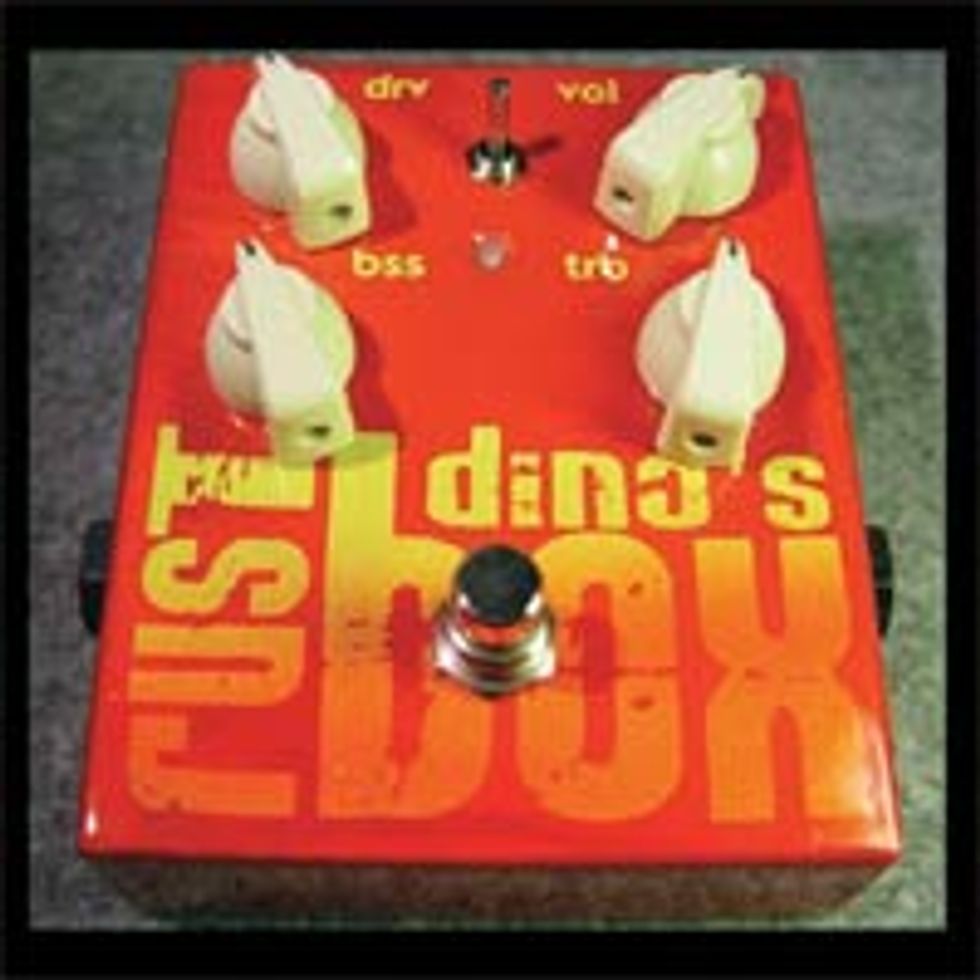 | |
| Download example 1 | |
| Recorded with a Steinberger ZT3 and a Mesa Boogie Rectifier | |
Italians have always seemed to possess a knack for luxury and a hint of the exotic. It is apparent in the vision of Alessio Casati and Andreas Bagnasco, the luthier duo of Dino’s Guitars. The long-time friends from Savona, Italy have dedicated themselves to the Italian tradition of craftsmanship manufacturing custom guitars, speaker cabinets, and hand-wired pedals since 1995. Dino’s Guitars Rust Box overdrive/distortion is the flagship of their pedal line. It’s housed in a lightweight aluminum chassis and assembled using a mix of PCB and point-to-point construction. Features include dedicated Bass and Treble knobs, as well as Drive/Gain and Master Volume controls. There is also a three way mini toggle switch that selects between three distinct levels of distortion for a nearly endless combination of distortion types, ranging from just a hint of crunch to a flat-out searing drive that any metal junkie would love.
Rigorously tested with numerous guitars and amps, the Rust Box showed great diversity: it performed exceptionally well with single coil pickups on a Fender Stratocaster, a Dano ’63 Reissue, and a Burns Steer Cutaway, all through a Fender Deluxe. The Rust Box also worked well on a ‘73 Fender Jazz Bass and an early-seventies Hagstrom Swede bass. The Treble and Bass knobs helped tailor the Rust Box to each instrument without over-coloring the instrument’s personal character.
All in all, the Rust Box is a very well built overdrive/distortion pedal capable of a great variety of flavors. If you are looking for an all-purpose box, it definitely warrants a closer look. – SS
Buy If...
you’re into a great overdrive unit with lots of tone shaping.
Skip If...
you’re on a tight budget.
Rating...
MSRP $260 - Dino’s Guitars - dinosguitars.com |
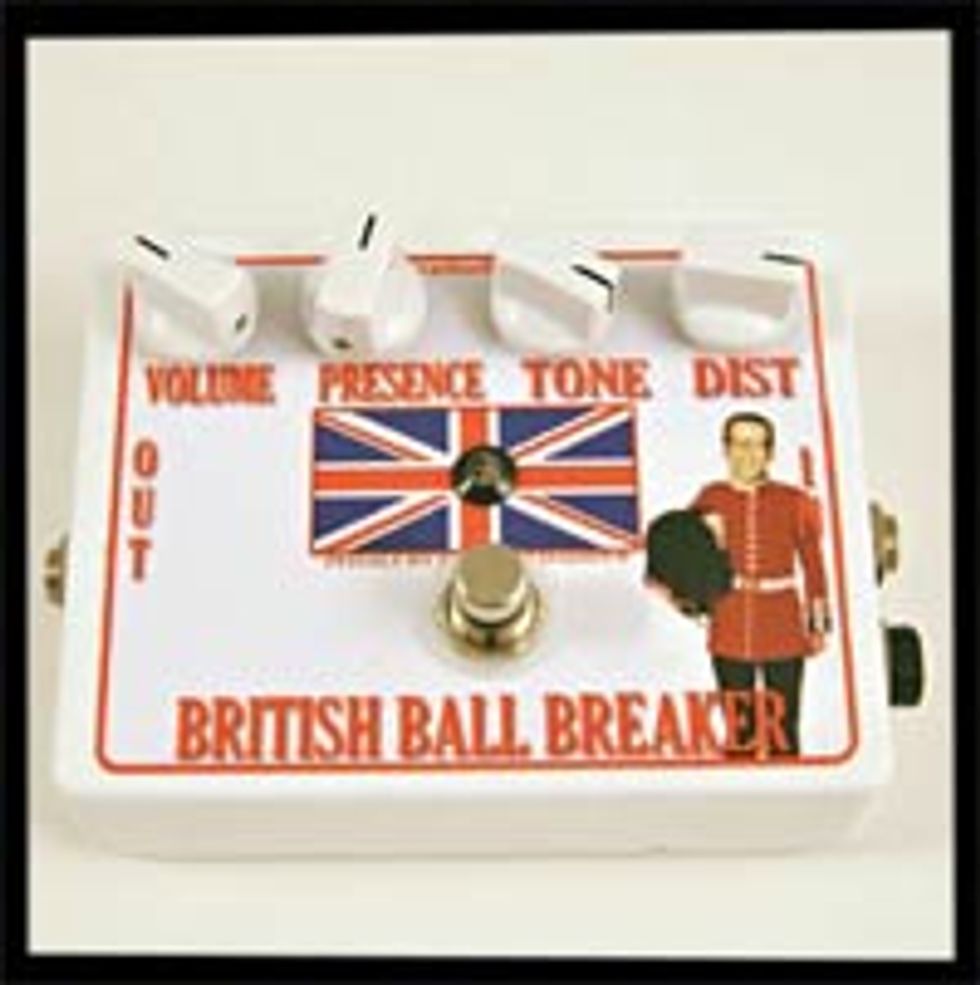 | |
| Download example 1 | |
| Recorded with a Burns Steer Cutaway and a Fender Deluxe | |
Professional musicians make their living by their tone, and no one knows it better than L.A. sideman Jeff Rubin, who’s shared the stage with artists like Oingo Boingo, Randy Jackson, and Chuck Berry. Jeff’s quest for tone led him to manufacturing his own hand-built pedals and Geek MacDaddy was born.
The latest offering is the British Ball Breaker overdrive/distortion, featuring a powder-coated aluminum chassis displaying Britain’s flag beside a jovial Rubin in guard’s uniform. The Ball Breaker uses Burr Brown opamps along with Wima, AVX, and Nichicon capacitors. The true bypass pedal also features Gain, Presence, Tone, and Volume controls for a number of tonal possibilities.
Keeping with British tradition, the Ball Breaker was tested with a Burns Steer Cutaway into the AC30-inspired Top Gain module of a Randall RM50. With Gain, Presence, and Tone all set at 12 o’clock, the Ball Breaker immediately nailed that classic British distortion reminiscent of Brian May or Jimmy Page. Adding some of the Ball Breaker’s Presence knob changed the character completely, leaning now more toward a Marshall-type tone, especially with the tone knob cranked.
Geek MacDaddy’s Ball Breaker is a great option for players looking for a warm, organic-sounding pedal. It responds like it’s actually part of your amp instead of a separate pedal. It may not be versatile enough for players in other genres like metal, but if you need classic overdrive this may be the box for you. – SS
Buy If...
you love the sound of classic British overdrive and distortion.
Skip If...
you need a modern scooped distortion sound.
Rating...
MSRP $205 - Geek MacDaddy - geekmacdaddy.com |
Bass Effects
Electro-Harmonix Bass Metaphors
Electro Harmonix has recently released a number of dedicated bass offerings, including the Bass Metaphors. The Bass Metaphors is an all-purpose channel strip and distortion in one box made from lightweight aluminum. It features separate Gain controls for clean and distorted settings, as well as a two-band EQ with dedicated EQ level. There is also a blend knob for mixing the effected signal with your dry bass tone, and a mini toggle that switches on a preset compressor. The pedal has an XLR Direct out as well as dedicated 1/4” outputs for effected or non-effected signal.
The Metaphors was tested as a DI on a master session, with the tone controls and blend set at twelve o’clock. It immediately sounded warm and round with a Tobias Classic six-string. Notes over the entire tonal spectrum were thick, and the Metaphors handled the B string well. There was a bit of top end hiss at first, but it was controlled easily after rolling off some treble. Engaging the distortion yielded a great, tube-like grind that any rock bassists would enjoy. Adding the Metaphors compressor immediately tightened up the overdrive’s definition, making it more articulate. Switching back to clean with an NS Design electric upright offered a huge amount of growl fretless players will love.
Bassists are utilitarian by nature, and this box does it all. If you are into doing the job with one pedal in your gig bag this might just be it. – SS
Aguilar Tone Hammer
The Tone Hammer provides three bands of EQ (with +/- 18 db of cut/boost plus sweepable mids), and a direct out (with pre/post and ground lift). It can serve as a preamp (even drives a power amp!) or DI, but also lets you switch between two vastly different sounds on the fly. For example, you could have a solo setting with added gain and tweaked EQ. Or you could alternate between a clean signal when bypassing the unit and an overdriven sound kicked in through the Adaptive Gain Shaping (AGS) circuit that adds a combination of drive and EQ.
The actual effect of the AGS varies with the amount of gain and the midrange settings. At low gain settings, you get a bit of edge and the tone stays round and full. At high gain settings, notes compress more and the mids move farther forward.
A handy feature is that—once switched on—the AGS stays ready to kick in when you engage the Tone Hammer’s circuit. And there’s an orange indicator light to remind you of that. One thing to watch for is that the Tone Hammer doesn’t have a separate level control dedicated to the AGS circuit.
It’s a sturdy unit that’s quality throughout, right down to the convenient slide-out battery drawer. The 18V Tone Hammer can be powered three ways—two 9V batteries (more headroom than a single battery), a power adapter (but not the 9V wallwart that runs the rest of your pedalboard), or phantom power from the house PA. – DB
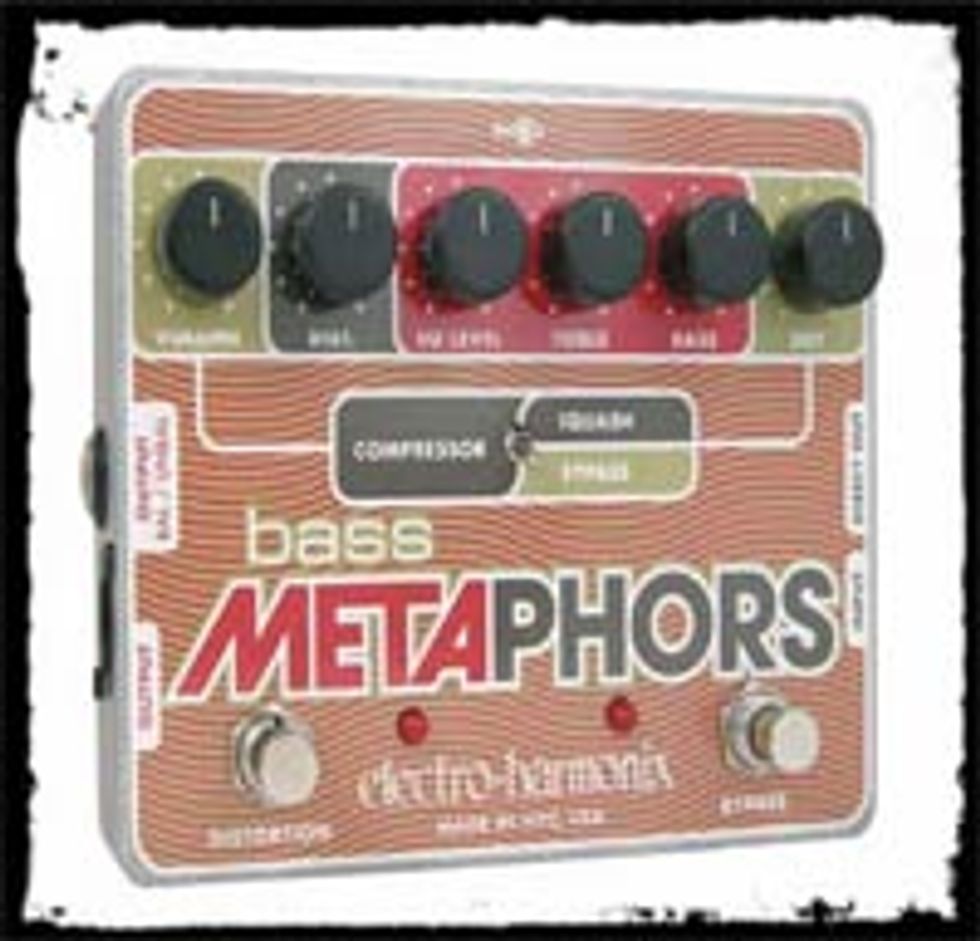 | |
| Download example 1 Clean | |
| Download example 2 Dirty | |
| Recorded with US Masters EP41PJ straight into Nuendo | |
Electro Harmonix has recently released a number of dedicated bass offerings, including the Bass Metaphors. The Bass Metaphors is an all-purpose channel strip and distortion in one box made from lightweight aluminum. It features separate Gain controls for clean and distorted settings, as well as a two-band EQ with dedicated EQ level. There is also a blend knob for mixing the effected signal with your dry bass tone, and a mini toggle that switches on a preset compressor. The pedal has an XLR Direct out as well as dedicated 1/4” outputs for effected or non-effected signal.
The Metaphors was tested as a DI on a master session, with the tone controls and blend set at twelve o’clock. It immediately sounded warm and round with a Tobias Classic six-string. Notes over the entire tonal spectrum were thick, and the Metaphors handled the B string well. There was a bit of top end hiss at first, but it was controlled easily after rolling off some treble. Engaging the distortion yielded a great, tube-like grind that any rock bassists would enjoy. Adding the Metaphors compressor immediately tightened up the overdrive’s definition, making it more articulate. Switching back to clean with an NS Design electric upright offered a huge amount of growl fretless players will love.
Bassists are utilitarian by nature, and this box does it all. If you are into doing the job with one pedal in your gig bag this might just be it. – SS
Buy If...
you need an all-purpose DI with distortion.
Skip If...
you need a fully adjustable compressor.
Rating...
MSRP $158 - Electro Harmonix - ehx.com |
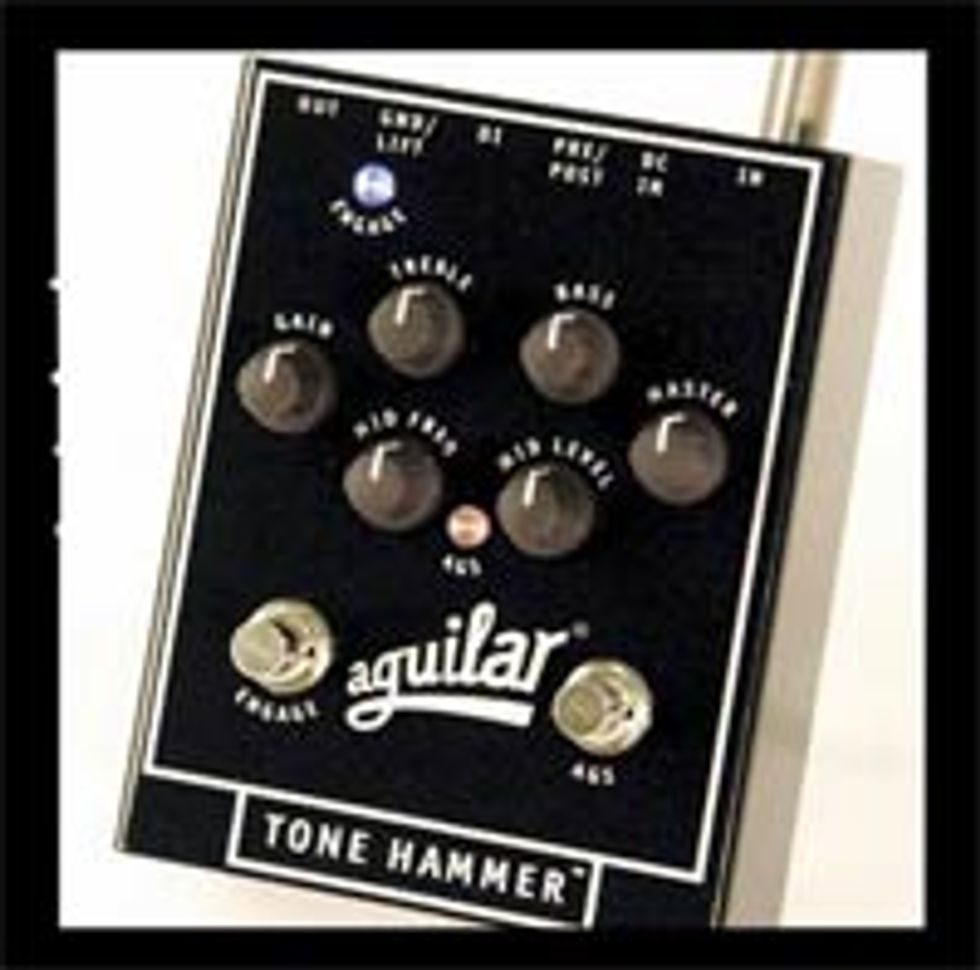 |
The Tone Hammer provides three bands of EQ (with +/- 18 db of cut/boost plus sweepable mids), and a direct out (with pre/post and ground lift). It can serve as a preamp (even drives a power amp!) or DI, but also lets you switch between two vastly different sounds on the fly. For example, you could have a solo setting with added gain and tweaked EQ. Or you could alternate between a clean signal when bypassing the unit and an overdriven sound kicked in through the Adaptive Gain Shaping (AGS) circuit that adds a combination of drive and EQ.
The actual effect of the AGS varies with the amount of gain and the midrange settings. At low gain settings, you get a bit of edge and the tone stays round and full. At high gain settings, notes compress more and the mids move farther forward.
A handy feature is that—once switched on—the AGS stays ready to kick in when you engage the Tone Hammer’s circuit. And there’s an orange indicator light to remind you of that. One thing to watch for is that the Tone Hammer doesn’t have a separate level control dedicated to the AGS circuit.
It’s a sturdy unit that’s quality throughout, right down to the convenient slide-out battery drawer. The 18V Tone Hammer can be powered three ways—two 9V batteries (more headroom than a single battery), a power adapter (but not the 9V wallwart that runs the rest of your pedalboard), or phantom power from the house PA. – DB
Buy If...
you’re looking for a versatile outboard preamp or a quality DI box that’s a good value.
Skip If...
you want to toggle between clean settings with EQ and an overdrive, while keeping approximately the same volume level.
Rating...
MSRP $189 - Aguilar - aguilaramp.com |
Miscellaneous
Pigtronix ASDR Attack Sustain
Introducing the Attack Sustain, a pedal that takes up a fair amount of real estate—about the size of three MXR pedals side-by-side—but features an airy layout, with three knobs on the upper left side (Attack, Decay, Sensitivity) and three more (Blend, Volume, Harmonics) on the right side, plus a tiny High Boost switch. Three footswitches—attack, Engage and Decay—line the bottom of the pedal and ultimately dictate how it is used. At this pedal’s simplest moments (only the Engage switch clicked) it acts as a compressor/ sustainer, with the Harmonics control adding a sweetening amount of harmonic distortion to your signal and the High Boost adding clarity and palpable punch. While the compressor alone would make this a good buy, it’s only scratching the surface of what the Attack Sustain is capable of.
Playing with the Attack knob will provide you with a variety of reversed, swelling sounds (vintage BOSS Slow Gear fans will have a blast here); tweaking the Decay knob opens up the possibility for stuttering, tremelo-esque effects. The manual lists 12 sample settings that should keep you busy, but this pedal has obviously been designed for experimentation. Because the attack/decay effects are directly triggered by the incoming signal strength, the Attack Sustain is extremely sensitive to your playing style—it may take a while to learn how to set the Sensitivity knob accordingly, but once you crack the code, it’s all golden.
In true Pigtronix style, the Attack Sustain is loaded with goodies, from the side-chain input that can be used to externally trigger the effect to true bypass construction. Oh, and it comes with its own power supply—a definite plus. If you’re a nut for envelope effects, or you’re looking to pick up a transparent compressor with a few extra tricks up its sleeve, you need this. – AM
ISP Technologies G-String Decimator
From the original Rocktron engineering team that designed the Hush noise reduction, ISP Technologies introduces the Decimator G String Pedal. The Decimator takes an innovative approach to noise reduction. All other noise reduction systems suffer from the same problem: they always treat short, staccato notes as if they’re the enemy. In a typical noise reduction system, a threshold must be set that immediately kills the unwanted noise, yet it compromises the tracking of both short staccato notes as well as longer, sustained notes. The Decimator uses Time Vector Processing, which instantly and accurately responds to all varieties of note durations. It tracks the guitar signal directly, and can be inserted into a series effects loop or at the end of your chain of badly behaved, noisy pedals.
The Decimator’s smooth chrome chassis is perfect for those narcissistic guitarists out there who will love seeing the reflection of themselves in their pedal! It consists of one threshold knob and an active/bypass switch. Operation is as simple as turning it on and adjusting the threshold knob until no noise or hum is present. I wanted to challenge the Decimator using my noisiest guitars so I chose both my Fender and Squier Stratocasters with three singlecoil pickups and plugged them into a variety of dirty overdrive, flanger and multieffects pedals, with the Decimator at the end of the chain. The hum and buzz was plentiful and annoying! I played a rhythm guitar figure with some chord stops and the Decimator successfully killed the extraneous noise instantly. It was also totally transparent and didn’t morph my guitar tone into some feeble shadow of its former self. (see audio sample 1)
I also tested the noise reduction by playing some long, sustained notes. I was pleased to hear the Time Vector Processing doing its job by fading the notes out smoothly instead of just choking the notes to certain death. It takes only a short while to adjust the threshold knob to your liking and adapt the noise reduction to your tone and playing style. (see audio sample 2)
Overall, the Decimator G String Noise Reduction pedal is a welcomed addition to any noisy guitar rig. With its ease of use, transparent operation and Time Vector Processing, it is a high quality performer in noise reduction.—GG
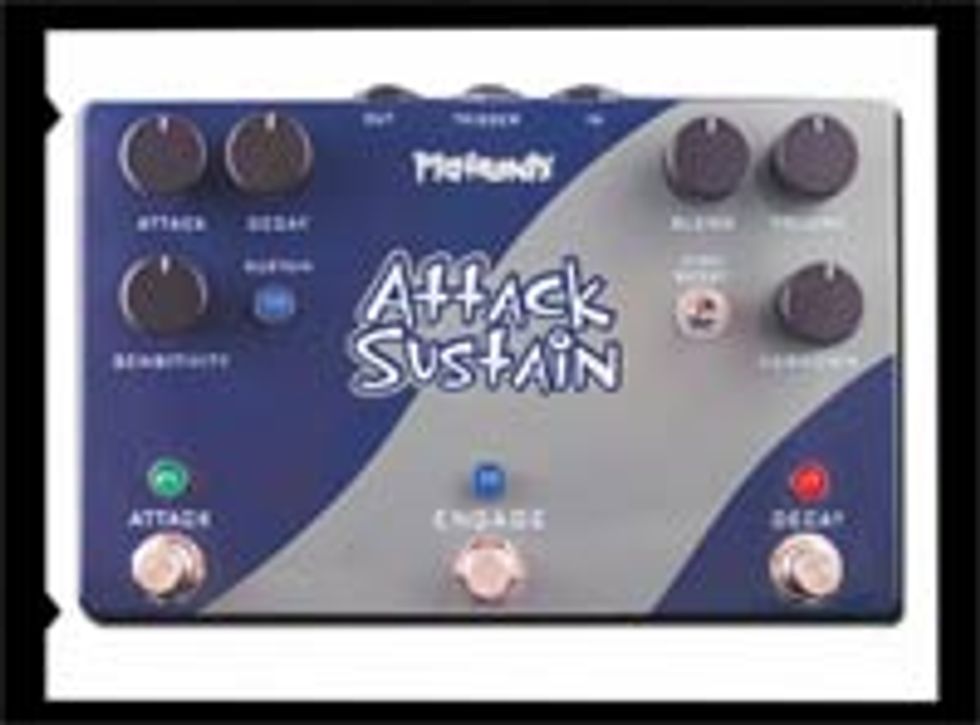 | |
| Download example 1 The Attack Sustainer on its "Slow Gear" setting. Recorded with a Fender SSH Strat | |
| Download example 2 A few bars of "Say It Ain''t So" in bypass mode, before clicking on the Attack Sustainer in its base compression mode. | |
| Download example 3 Some slow chords played through the Attack Sustainer''s "Tube Tremolo" setting. | |
| Recorded with an Ampeg AMG100 and a modified Epiphone Valve Junior stack featuring an Eminence Red Coat 12”, through a Shure SM57 and into a ProSonus Audiobox interface. | |
Introducing the Attack Sustain, a pedal that takes up a fair amount of real estate—about the size of three MXR pedals side-by-side—but features an airy layout, with three knobs on the upper left side (Attack, Decay, Sensitivity) and three more (Blend, Volume, Harmonics) on the right side, plus a tiny High Boost switch. Three footswitches—attack, Engage and Decay—line the bottom of the pedal and ultimately dictate how it is used. At this pedal’s simplest moments (only the Engage switch clicked) it acts as a compressor/ sustainer, with the Harmonics control adding a sweetening amount of harmonic distortion to your signal and the High Boost adding clarity and palpable punch. While the compressor alone would make this a good buy, it’s only scratching the surface of what the Attack Sustain is capable of.
Playing with the Attack knob will provide you with a variety of reversed, swelling sounds (vintage BOSS Slow Gear fans will have a blast here); tweaking the Decay knob opens up the possibility for stuttering, tremelo-esque effects. The manual lists 12 sample settings that should keep you busy, but this pedal has obviously been designed for experimentation. Because the attack/decay effects are directly triggered by the incoming signal strength, the Attack Sustain is extremely sensitive to your playing style—it may take a while to learn how to set the Sensitivity knob accordingly, but once you crack the code, it’s all golden.
In true Pigtronix style, the Attack Sustain is loaded with goodies, from the side-chain input that can be used to externally trigger the effect to true bypass construction. Oh, and it comes with its own power supply—a definite plus. If you’re a nut for envelope effects, or you’re looking to pick up a transparent compressor with a few extra tricks up its sleeve, you need this. – AM
Buy If...
you want a great compressor and a bevy of cool envelope effects
Skip If...
you don’t have the patience to tweak.
Rating...
MSRP $399 - Pigtronix - pigtronix.com |
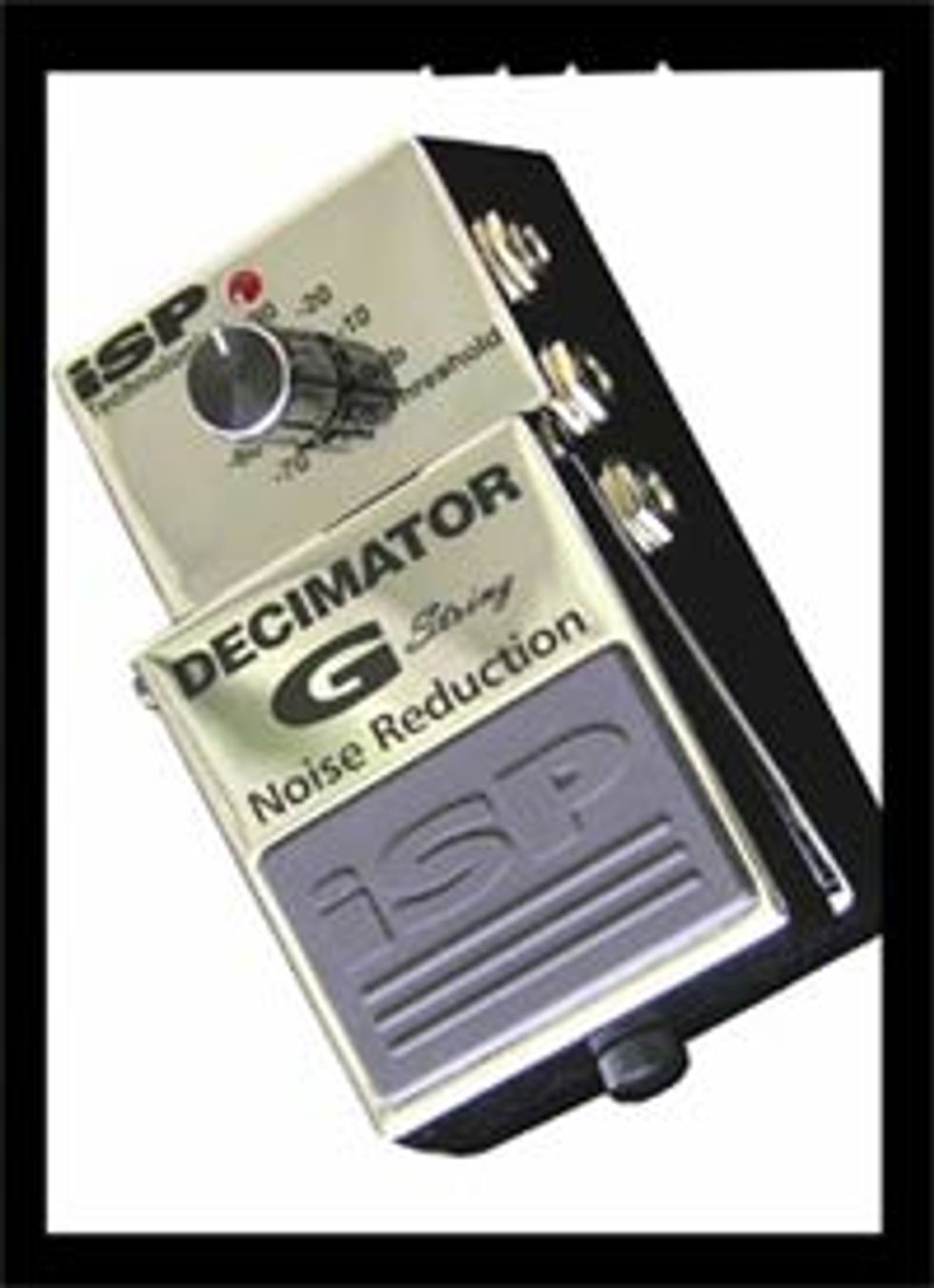 | |
| Download example 1 | |
| Download example 2 | |
| Recorded with a Squier Affinity Stratocaster with single coil pickups into a series of effects that included: Fulltone Full Drive 2, MOSFET Overdrive, Electro-Harmonix Holy Stain, Source Audio Soundblox Flanger into the Decimator G String. The signal was sent to a C.B. Evans Spitfire Amp into a Marshall Lead 1960 4x12 cab. Mic''ed with a Shure SM57 into the preamp of a Yamaha 02R Digital Mixing Console, recorded into Pro Tools. | |
From the original Rocktron engineering team that designed the Hush noise reduction, ISP Technologies introduces the Decimator G String Pedal. The Decimator takes an innovative approach to noise reduction. All other noise reduction systems suffer from the same problem: they always treat short, staccato notes as if they’re the enemy. In a typical noise reduction system, a threshold must be set that immediately kills the unwanted noise, yet it compromises the tracking of both short staccato notes as well as longer, sustained notes. The Decimator uses Time Vector Processing, which instantly and accurately responds to all varieties of note durations. It tracks the guitar signal directly, and can be inserted into a series effects loop or at the end of your chain of badly behaved, noisy pedals.
The Decimator’s smooth chrome chassis is perfect for those narcissistic guitarists out there who will love seeing the reflection of themselves in their pedal! It consists of one threshold knob and an active/bypass switch. Operation is as simple as turning it on and adjusting the threshold knob until no noise or hum is present. I wanted to challenge the Decimator using my noisiest guitars so I chose both my Fender and Squier Stratocasters with three singlecoil pickups and plugged them into a variety of dirty overdrive, flanger and multieffects pedals, with the Decimator at the end of the chain. The hum and buzz was plentiful and annoying! I played a rhythm guitar figure with some chord stops and the Decimator successfully killed the extraneous noise instantly. It was also totally transparent and didn’t morph my guitar tone into some feeble shadow of its former self. (see audio sample 1)
I also tested the noise reduction by playing some long, sustained notes. I was pleased to hear the Time Vector Processing doing its job by fading the notes out smoothly instead of just choking the notes to certain death. It takes only a short while to adjust the threshold knob to your liking and adapt the noise reduction to your tone and playing style. (see audio sample 2)
Overall, the Decimator G String Noise Reduction pedal is a welcomed addition to any noisy guitar rig. With its ease of use, transparent operation and Time Vector Processing, it is a high quality performer in noise reduction.—GG
Buy If...
you wish to be convicted in the murders of Hum, Buzz and Noise.
Skip If...
You actually enjoy wallowing around in your guitar tone’s noisy mess.
Rating...
MSRP $249 - ISP Technologies - isptechnologies.com |



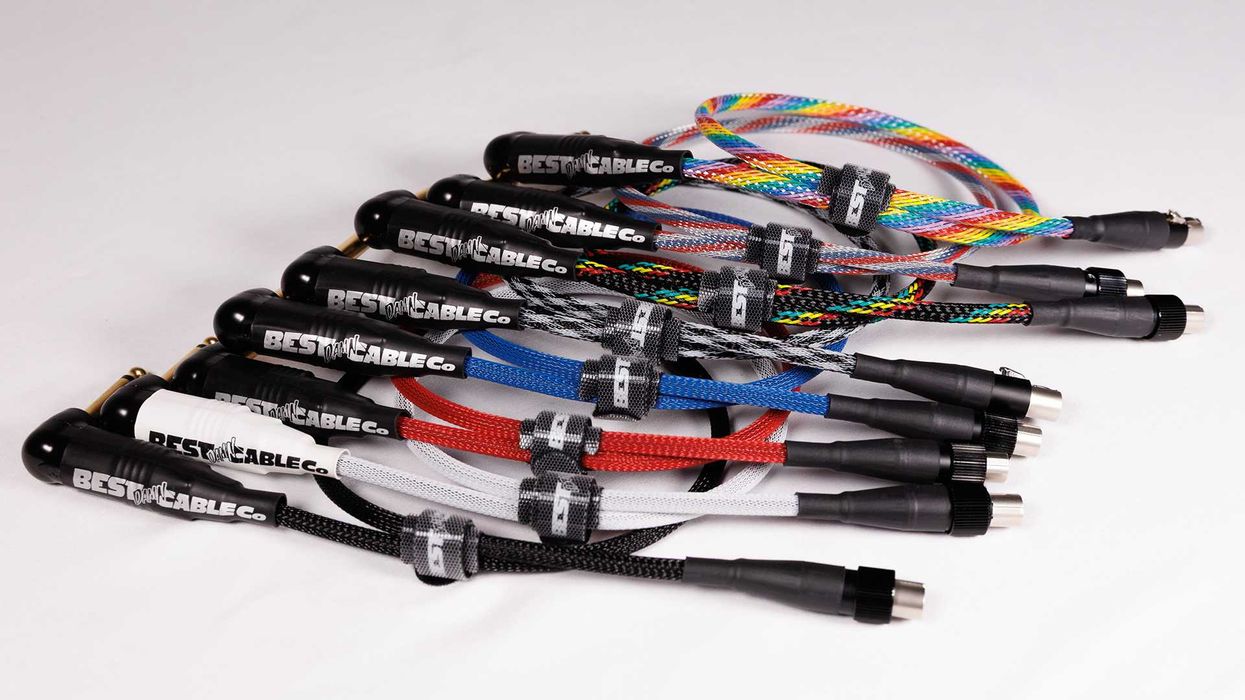
![Devon Eisenbarger [Katy Perry] Rig Rundown](https://www.premierguitar.com/media-library/youtube.jpg?id=61774583&width=1245&height=700&quality=70&coordinates=0%2C0%2C0%2C0)








